Posts Tagged ‘Shlomo Wiesel’
Friday, June 9th, 2017
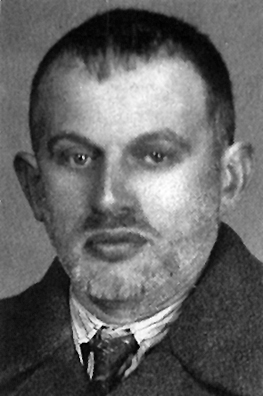
Shlomo Wiesel, Elie’s father, in 1942, a young looking man.
By Carolyn Yeager
Elie Wiesel wrote two ‘official’ accounts of his 1944-45 concentration camp experience: his novel Night (1958) and his official autobiography (Part One), All Rivers Run to the Sea (1995). Thirty-seven years separate these two publications.
Three articles written by me in 2011 (and here) and 2012 contain information that demonstrate conclusively that Night is not a true account of the experience Wiesel may have had with his family at Auschwitz-Birkenau in 1944. Night is written for “effect” and to be a gripping father-son drama that rises to the standards of a literary work of art. Night cannot, therefore, be called Wiesel’s testimony – a claim he made on several occasions.
Because a lot of information was conveyed in these three articles – a lot of details were covered, and I had other purposes in mind – this crucial fact easily gets lost to the reader’s attention. In this article I will zero in on this “crucial evidence” in order to make it crystal clear why Night can only be considered a work of fiction and Elie’s autobiography “All Rivers …” is the place to go for Elie’s ‘true’ account of his experience.
The main evidence I want to put up front is the agreed upon birth date of Elie’s grandmother Nisel Bash Wiesel, mother of Shlomo and Mendel and four daughters. In 1957, Yaakov Fishkovitz filled out a Yad Vashem Page of Testimony (PoT) for his aunt Nisel, stating she was born in 1881 in Chust, Romania and died at Auschwitz in 1944. In 1999, Eliezer Shlomovitz, living in Los Angeles CA at the time, also filled out a PoT for Yad Vashem giving his grandmother’s birth year as 1880, with a question mark. Elie Wiesel never filled out a form for his grandmother, whom he wrote he was very close to, nor for his mother or sister, but only one for his father.
Why Grandma Nisel’s birth date is so important
A birth date of 1880-81 makes Grandmother Nisel 63 or 64 years old in 1944, a figure agreed upon by Hilda Wiesel. However, the story line in Night, accepted as factual by writers, journalists and Internet sources like Wikipedia, gives Father’s age as 50 in 1944, which, if true, would mean grandmother Nisel was only 13 or 14 years old when she gave birth to Shlomo, her third child, and only 11 or 12 at most when she gave birth to her first child. Such a shockingly young age is not in the tradition of Hasidic Judaism to which the Wiesels’ belonged.
In the scene in Night when the family arrives at Birkenau around midnight, Father tells a fellow prisoner who questions him that he is 50 years old and the prisoner urges him to say he is younger. Similarly Eliezer says he is “not quite 15” and is told to make himself older. He subsequently answers “eighteen” when questioned by the guard (or Mengele?). Both men are passed on through. From this, and apparently this alone, the default birth date for Shlomo Wiesel became 1894 and no one, including Elie, ever questioned or corrected that. However, Elie slyly left blank the date of birth on the Yad Vashem PoT he filled out for his father in 2004, and he never offered a birth date for either of his parents.
Wiesel adds 10 years to Father-son age difference in Night
In 1957, Yaakov Fishkovitz also filled out a Yad Vashem PoT for his cousins Shlomo and Mendel Wiesel, giving their dates of birth as 1903 and 1905 respectively. These are probably correct because it makes their mother Nisel age 22 or 23 when Shlomo, her third child, was born, and age 24-5 when Mendel, her fifth, was born.
So why did Elie, in writing Night, make Father 50 years old instead of his real father’s age of 41? Answer: To make the theme of a role reversal between father and son more dramatic, of course. To deepen the loneliness felt by the boy watching his worn-out father break down under the cold, uncaring death machine perpetrated by the evil German Nazis. To write the most heart-breaking story he could!
For the same reason, his 10-year old sister became seven years old and he even made himself a year younger (14 going on 15 instead of 15 going on 16).
It couldn’t be more clear that his purpose in writing Night was different than his purpose for All Rivers, which attempts to give a record of his early life and actual family history. In fact, while Wiesel writes pretty extensively about his grandmother Nisel, who even accompanied the family to Auschwitz in All Rivers – she doesn’t appear at all in Night. He left her out as extraneous to his tightly-constructed narrative, the purpose of which was not to tell it as it really happened.
Summing up
So when the facts diverge between the two books, as they often do, go with All Rivers as the more accurate version. For example, in Night, Eliezer is in the hospital at Birkenau in January 1945 with an infected foot. In All Rivers, he tells the very same story but it is not his foot at all, but his knee that is operated on! If there is any truth to the story, which can be considered doubtful, accept that it was his knee. (I think Elie, or one of his Night editors, liked the dramatic image of leaving a trail of red blood in the snow, so what the heck, just change knee to foot!)
To sum up, Wiesel’s willingness to change important details about his family, and his own major experiences, tells us that creating a “true account” of their year of internment was not his goal. For him, no different from most survivors who write memoirs, he preferred what was “true in his mind.” Or, in other words, what made for a better and hopefully more successful book.
2 Comments
Category Featured | Tags: Tags: All Rivers Run to the Sea, Auschwitz-Birkenau, Buchenwald, Grandma Nisel Wiesel, Night, Shlomo Wiesel,
Social Networks: Facebook, Twitter, Google Bookmarks, del.icio.us, StumbleUpon, Digg, Reddit, Posterous.
Saturday, March 5th, 2016
Followup of “Elie admits he doesn’t have the tattoo A7713”
By Carolyn Yeager
copyright 2016 Carolyn Yeager
![Elie Wiesel's left arm in bright sunlight in a still from his own video "Elie Wiesel Goes Home" - no retouching. [courtesy Eric Hunt]](https://www.eliewieseltattoo.com/wp-content/uploads/2012/01/EW_arm-no-tattoo1-e1450887466391.jpg)
Elie Wiesel’s left arm in bright sunlight in a still grabbed from his own movie “Elie Wiesel Goes Home” – no retouching possible. [courtesy Eric Hunt]
Turns out? How long do we wait for something to “turn out?”
Wiesel will be 88-years-old on September 30th of this year. Very few human bodies are able to carry on after their 90th year, so, without a consensus opinion from the revisionist community, we are looking at the prospect of an eternal “We’ll never know” pasted over the Elie Wiesel tattoo question. Naturally, this is what Wiesel supporters want, but should revisionists be content with never going beyond that, continuing to fear there will come a time he will dramatically pull up his sleeve for the cameras?
He’s already done so and we have the result in the image at right.
And what don’t people understand about logic? One doesn’t need a University course in logic to use common sense. Two plus two adds up to four – we don’t need a calculator to prove it, our fingers can tell us. What should we think of those who would say “But what if it doesn’t? What if our fingers turn out to be wrong?”
It’s the same logic we use when someone tells us he has a number tattooed on his arm that proves he was at Auschwitz in 1944 – we expect it to be shown to us. There is no reason we should have to take it on trust. Imagine yourself in a real life situation like that and you’ll get it. Those who are willing to accept a deal such as we have in the case of Elie Wiesel are either cowards, frightened serfs, or collaborators in the lie. But people are also ignorant of the facts – even though mostly through choice, and maybe also poor memory.
For this reason, I want to specifically address these persons to try to give them a little backbone … er, I mean background. You need to be clear about how Elie Wiesel got into this tattoo quandary to begin with.
To those whose reasoning goes, Why would Wiesel say he has a tattoo when he doesn’t have one? He wouldn’t be so foolish, therefore I have to assume he might have one. He also doesn’t need to have a tattoo to have been at Auschwitz, – they forget about the Yiddish book, Un di Velt hot gesvign (And the world remained silent), from which Night was taken. In that book, and carried over to Night, Eliezer and his father were tattooed on their left forearms with A7713 and A7712. It follows that if Night is Elie Wiesel’s own story, he has to have a tattoo.
On page 51, the author wrote:
The three “veterans,” with needles in their hands, engraved a number on our left arms. I became A-7713.
Now I hope you understand (and please don’t forget it again) why he has to have that particular tattoo, and why he has always said he does have it. He has no choice. The fact that it has never been shown to the public speaks volumes (never underestimate his belief in his ability to fool the public), as well as the fact that we’ve seen his uncovered left arm in photographs and there is no such number there. What more proof do you want? The final nail in the coffin is that Wiesel and the people around him remain silent about it – they will not allow the question to be asked. That is the “admitting” part.
So it’s settled – Wiesel has no tattoo, and he admits as much. He’s kept up the lying charade so long because he could! No one challenged him. Once again, I will give credit to Jew Michael Grüner for breaking this open, even though he makes up plenty of ridiculous concentration camp stories himself. But Grüner got the documents and made them public, along with explanatory letters from Auschwitz and Buchenwald.
If Wiesel is not a concentration camp survivor, we need to look into other possibilities for his whereabouts in 1944. We will not be able to prove anything – this period of time could not be more confused. Displaced persons and self-identified camp survivors were flocking into Western Europe in search of opportunities; they were creating new identities and applying to go to Israel and to America. In all of this, it’s impossible to find any kind of a trail. But some pathways are more plausible than others for the Wiesel family.
Wiesel’s family is not found in records at Auschwitz
Speaking of documents, do you know there is no record of any member of Wiesel’s immediate family at Auschwitz? That’s a fact. In addition, the only record, as far as I know, of Elie’s two older sisters being at the Dachau sub-camp Kaufering comes from a book put out by the “Central Committee of Jews in Bavaria” in 1946. They published a list of 61,387 Jews in a book named Sharit Ha-Platah (translates as “Counted Remnant”), among which are listed Hilda and Bea Wiesel. The names were collected by Chaplain (Rabbi) Abraham Klausner, who is said to have visited many of the camps in southern Germany where survivors gathered in late 1945 and 1946. You better believe the Rabbi wanted to get as many names as possible, and that there is nothing official about this list.
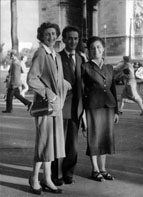
Bea, Elie and Hilda Wiesel in Paris after the war.
We first meet up with Hilda and Bea as refugees in Germany, just as we first meet up with Elie at a Jewish orphanage in France. Hilda Wiesel married an Algerian Jew and moved with him to Paris. She has since spoken about her family’s deportation in a Shoah Foundation videotaped interview, but without details of what happened after they arrived at Auschwitz. Her sister Batya (Bea) emigrated to Canada and never spoke publicly about it at all.
Hilda’s Shoah Foundation testimony which she gave in 1995 (coincidentally the same year Elie’s official autobiography All Rivers Run to the Sea came out) differs from her brother’s story in Night in numerous details. Relevant here, she said:
We were deported on 15 May [1944]. We heard around 1943, because we had family in Belgium, we heard that they had deported a cousin, but we didn’t know where to …
I can only tell you one thing, that the third transport – we had to stand 5 by 5, five abreast – there were Hungarian gendarmes, hardly any Germans, mostly Hungarian gendarmes.
We were myself and my sister, the one who was in Canada and is now deceased; my mother; my grandmother, that is my father’s mother; and, oh … my little 10-year old sister. And we arrive in Auschwitz, the men were apart, my father with my brother.
According to the original Night and the Yiddish And the world remained silent, the family’s deportation date was June 3, 1944. In Marion Wiesel’s re-translation, it was changed to May 20. So which is correct? Most likely none.
Hilda also tells us the women and men traveled in separate cars.
My mother knew there was no hope, because she told me and my sister, always stay together, always stay together. And she said, go tell your dad to always stay together with Elie. And I ran over to him and said, Papa, stay with Elie, stay with him – like that.
Q: This was on the train, that you are describing?
A: No, it was after getting off the train.
If they were in the same train car, Mother could have told her husband herself. But Night and its Yiddish precursor describe the boys and girls having sex together in the darkness of the train, freed from following the usual rules, and Wiesel says he was traveling with his mother and sister — everyone was together. Let me make clear that I don’t have any more faith in 70-year old Hilda Wiesel Kudler’s testimony than I do Elie Wiesel’s “stream-of-consciousness” autobiography, which, as I said, coincidentally appeared at the same time in 1995. And I am not convinced by this that the family really went to Auschwitz since not one of them was registered there, nor do their names come up on any hygiene or other reports even though they were supposedly put in quarantine. We do find Lazar and Abraham Wiesel, and Myklos Grüner, his father and brother listed on a hygiene report.
I’ll also add that Mother, Grandmother and youngest sister [10 years-old according to Hilda Wiesel, but 7 years-old according to Elie in Night, where Grandmother is not included] are understood to have been sent directly to the “gas chamber” and gone up in smoke through the chimney shortly thereafter. Since homicidal gas chambers didn’t exist, all the women would have been sent to the showers, gone through the disinfection process, given new clothing and assigned to a women’s barrack, the same as Wiesel writes about Eliezer and Father. However, a grandmother and mother with a child would have been assigned to non-working barracks; the two 20-somethings to barracks for female workers.
A very odd fact is that both in Night and in the Yiddish book, Eliezer and Father never mention their wife, daughters, mothers and sisters again. They don’t look for them, talk or ask about them, as other people did. They apparently accept being told that their loved ones “went up the chimney” and immediately become concerned only for themselves. I don’t believe this; it’s not human nature, it’s make-believe.
So if not there, where else could the Wiesel family have been in 1944?
Following a trail of possibilities
Well, we do have Shlomo and Mendel Wiesel’s first cousin Yaakov Fishkowitz filling out a Yad Vashem Page of Testimony for each of them, reporting they both died in 1943 in a “labor camp.” If Yaakov didn’t believe this were true, why would he have done this in 1957 at the same time he filled out other pages for relatives he marked as being sent to Auschwitz in 1944? He also said Shlomo was born in 1903 and Mendel in 1905.
Add to this the very weak story Elie Wiesel gives for why his family didn’t do something to protect themselves from the “Nazi menace.” On page 8 of Night, Wiesel wrote:
In those days it was still possible to buy emigration certificates to Palestine. I had asked my father to sell everything, to liquidate everything, and to leave. ‘I am too old, my son,’ he answered. ‘Too old to start a new life. Too old to start from scratch in some distant land …’
Too old at the age of 41? Fishkowitz puts his birth in 1903. Other than that, there is no official birth date for Elie Wiesel’s father. In a close family, children always know their parents’ age and birthday. Hilda said her mother was born in 1900. So Shlomo Wiesel’s age is being covered up by son Elie, who left blank the DoB space on the Page of Testimony he filled out for his father. We can say that the oldest Shlomo could have been was 48, but more likely younger. Wiesel has always made his father out to be a tired old man, especially in Night. I have distrusted this characterization and believe it was a literary device to make the story more poignant, just like turning 10 year-old Tsipora into a 7 year-old.
The following interesting passage is on page 27 of the Yiddish Un di Velt hot gesvign, but is not included in the shorter French or English Night:
We had opportunities and possibilities to hide with regular goyim and with prominent personalities. Many non-Jews from the surrounding villages had begged us, that we would come to them. There were bunkers available for us in villages or in the mountains. But we had cast aside all proposals. Why? Quite simple: the calendar showed April 1944 and we, the Jews of Sighet, still knew nothing about Treblinka, Buchenwald and Auschwitz.
Two things here. It again says it was April, not May, when the Sighet Jews first learned they would be deported. It confirms the passage on page 83 of the Yiddish book: “It was a beautiful April day,” said on one of their first days in Auschwitz-Birkenau.
The other thing – it is not true the Jews of Sighet knew nothing, yet that is what Wiesel writes in his autobiography All Rivers, while at the same time he also writes of Polish Jews passing through their neighborhoods telling stories of terrible atrocities by German occupiers. He says that non-Jews offered the Wiesel family places to stay. Wiesel writes that their Christian maid Maria begged them to come to her village and she would keep them safe. How many Jews may have taken advantage of such offers? But we’re told that Shlomo Wiesel refused to accept this kindness of Christians, and Elie’s only explanation is that they still didn’t believe the stories they were hearing. Then he blames the world for not warning them! This can be found in All Rivers Run to the Sea, on page 63 and 68-69.
Isn’t is possible the reason we find mention of these offers of help in all three Wiesel books is because it was such an important part of his experience that he felt compelled to include it? His family hid out and were protected from arrest. Or … maybe only he was sent away for safety, and his mother and sisters had different experiences. His father too, unless he did indeed die in 1943.
After the war, when only Elie and his two older sisters reunited, it was convenient to say the others were “murdered” in Auschwitz. That was the preferred story at the time. After all, with an advertised death toll of four million until 1990, there was plenty of room to say hundreds of your relatives were exterminated there.
In France
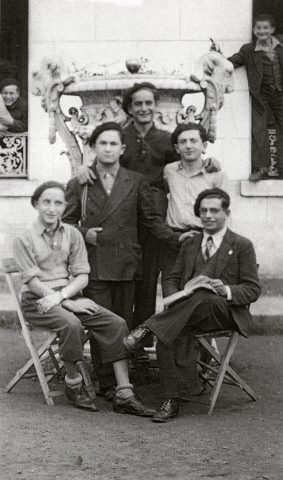
Elie Wiesel is center-top with a group of friends all wearing berets, at Ambloy, France in 1945.
Wiesel could have been sent to the home for Jewish orphans in France after the war from wherever he had been staying. In the few photographs we have, he looks cheerful and well-adjusted. He has friends, and seems to be a leader of younger boys. His hair is very long in the front, too long to have grown out from a concentration camp shaved head just a few months before.
From his very first year in France he was extremely interested in Zionism, the struggle in Palestine, and was a supporter of the Irgun, the Jewish terrorist organization in Palestine. Where did he learn all this, since he says that while in the camps he had no interest in anything. This is another reason to suspect he sat out the “Hungarian Holocaust” and was staying in a safe political environment somewhere.
I have written so many details in the various articles on this site that suggest or show outright that Wiesel has lied about many, many things – that he is faking it when it comes to so many aspects of his story. It’s not like he’s a paragon of truthfulness and I am therefore going out on a limb, or defaming him, by questioning the basics of his story. What really gives me a justification to do so comes back to – yes, that’s correct, his lack of a tattoo!
I think it shows that Wiesel and his friends know how damaging this tattoo business is by the fact they won’t speak about it – they completely refuse to deal with it. The Jewish Shoah believers in France at Enquete & Debat tried but could not get Wiesel to answer any questions about the tattoo by writing to him at his Foundation office in Romania. After a period of time they phoned there and Wiesel’s assistant hung up on them as soon as she realized what they were calling about. If holocaust-believing Jews are treated that way, it tells us just how unwelcome the topic is.
As I’ve said before, the only way to bring attention to Wiesel’s serious tattoo problem is to make a lot of noise about it – to get public attention on it. This is not happening and will not happen as long as the general response is: Forget the tattoo because it might turn out that he has one.
The cowardice in such a position leaves me flabbergasted. It’s half ignorance, as I said above, that is true, but the other half is lack of nerve. I am doing my best to dispel the ignorance. Those promoting the Wiesel legend lie, lie, lie, lie, lie and it doesn’t bother them in the least, while the truth forces are afraid of being wrong when the odds for being wrong on this are 5% or less – to me, it’s 0%. To continue to be content with just asking the question “Is it possible that Elie Wiesel doesn’t have the tattoo he said he does?” and fail to go beyond that to a declarative statement on the matter is not an acceptable outcome considering all we know.
It’s time to put all doubts aside and claim the obvious.
8 Comments
Category Featured | Tags: Tags: Auschwitz, Elie Wiesel, Hilda Wiesel, Night, Shlomo Wiesel, Un di Velt Hot Gesvign, Where's the Tattoo?,
Social Networks: Facebook, Twitter, Google Bookmarks, del.icio.us, StumbleUpon, Digg, Reddit, Posterous.
Wednesday, March 7th, 2012
By Carolyn Yeager
copyright 2012 Carolyn Yeager
Elie Wiesel questioned under oath in a California courtroom in 2008:
Q. And is this book Night that you wrote a true account of your experience during World War II?
A. It is a true account. Every word in it is true.
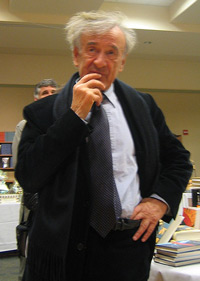
Elie Wiesel manning his table at a Jewish book fair in Austin, TX, 2006. The new translation of Night by his wife Marion had come out in January of that year, and it was immediately chosen for Oprah Winfrey’s book club.
In Part One, I established that the decision to rebrand Night into an autobiography was the reason for a new translation, in which necessary changes could be made to better ‘fit’ the story both to the real Elie Wiesel and the known facts of the Hungarian deportation.
When the 2006 translation came out, with its new classification to “autobiography,” questions arose from some circles. Responding to these questions, Edward Wyatt wrote an article in the NewYork Times on Jan. 19, 2006, in which he quoted Jeff Seroy, senior vice president at Farrar, Straus & Giroux, parent company of Night publisher Hill & Wang, as strongly denying that changes were made to bring the book more in line with the facts. “Nonsense,” said Seroy. “Some minor mistakes crept into the original translation that were expunged in the new translation. But the book stands as a record of fact.”
Blaming the Translator
“Mistakes in the original translation” can only mean mistakes by Stella Rodway, the original translator! But we have already shown that Stella Rodway faithfully reproduced the French La Nuit, which was Wiesel’s own work. The author and publisher are casting these changes as translation errors to divert attention away from Elie Wiesel’s own errors—part of their campaign to pass Night off from now on as “a record of fact.”
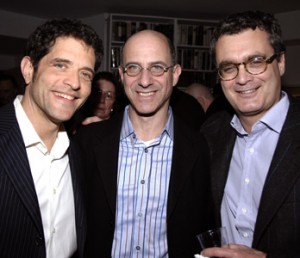
Publisher Jeff Seroy, center, with writer Brad Gooch to his left, Doug Stumps on his right .
A record of fact it isn’t
When I ended Part One, Eliezer and Father were still in the train car on their way to Buchenwald. You will recall that the Yiddish, the French and thus the original English version of Night specified the trip took 10 days and 10 nights from Gleiwitz (on the former German/Polish border) to Buchenwald. Since we know from standard historical sources1 that the prisoners were evacuated from Monowitz on Jan. 18 and arrived in Gleiwitz the next day, Jan. 19; and since according to the description in Night itself, they spend three days in Gleiwitz (Jan. 20-22), this would make their day of arrival February 1, 1945. But in Night, Father’s death takes place the night of Jan. 28-29, three days before they arrived! This is why Marion Wiesel removed the number 10 in her new translation, leaving the number of days and nights undetermined.
A strange detail that actually belongs in Part One is on page 87 of the original Night. Eliezer remarks, after his and his Father’s deliberations and final decision to go on the march: “I learned after the war the fate of those who had stayed behind in the hospital. They were quite simply liberated by the Russians two days after the evacuation.” The evacuation, as we all know, was on the 18th. We also know the Russians did not arrive on the 20th of January! The actual liberation day is January 27. What possessed Wiesel to write this? Well, because it was in Un di velt: “Two days after we had left Buna, the Red Army occupied the camp. All the sick had stayed alive.”
From the point in the story of Eliezer and Father’s arrival at Buchenwald there are no significant changes made by Marion Wiesel to the original French and English versions. But there is much in all the versions that differs strikingly from the “official holocaust history” as written by acknowledged official chroniclers such as Danuta Czech. So I will continue with comparisons between Night and “official history,” along with some very significant changes made from Un di velt hot geshvign to Wiesel’s edited French La Nuit.
Arrival at Buchenwald: 26 Jan. or 1 Feb.?
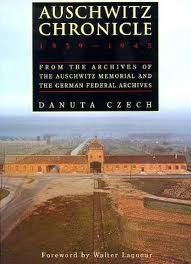 Danuta Czech, in her Auschwitz Chronicle1, records that on January 26,
Danuta Czech, in her Auschwitz Chronicle1, records that on January 26,
A transport with 3,987 prisoners from Auschwitz auxiliary camps reaches Buchenwald. There are 52 dead prisoners in the transport. 115 prisoners die on the day of arrival. Their corpses are delivered to the autopsy room. (P 801)
This is the transport that carried Lazar and Abraham Wiesel/Viezel, Miklos (Nikolaus) Grüner and all of the inmates of Monowitz whose names are on the transport list.2 According to Czech, the Monowitz prisoners began their march on the evening of January 18, 1945, with “divisions of nurses placed between the columns” of 1000 each (P 786), arriving at Gleiwitz Camp the following evening. On Jan. 21 “they are loaded in open freight cars with other prisoners from Auschwitz who have arrived in Gleiwitz.” (P 788) From Jan. 21 to Jan. 26 is five days of travel … not ten, as Wiesel wrote in Night.
The narrative in Night gives us a date of Jan. 22 for the boarding of the train, one day later than Czech. And while Night gives the number of days on the train (10), it does not name the date of arrival.
Hilda Wiesel says her father died on arrival
Totally contradicting what is written in Night, Hilda Wiesel Kudler, Elie’s oldest sister, in her testimony for the Shoah Foundation in 1995, said she learned from her brother that their father died as he stepped off the train.
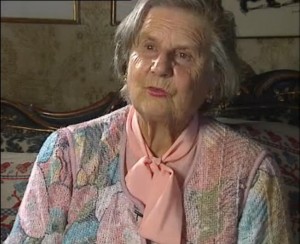
Hilda Wiesel Kudler, in France, giving her videotaped testimony to the Shoah Foundation
And I said, where is father? And he replied, he’s gone back to Sighet; he[Elie] didn’t want to tell me [that he was dead]. And I repeated, but where is he? And he insisted he was at Sighet. And I said, look, I want you to tell me the truth. Because he knew the date of my father’s death. You know, they did a long march3 from Auschwitz, then they put them on the train to go to Buchenwald; he died gasping for air; when he stepped off the train, he died gasping for air; at Buchenwald. But he[Elie] knew the date.
From this, we can better understand something about Elie Wiesel—that he has never had a problem with making up stories that “sound better” than the truth. But, if Hilda is correct in her recall, and if their father really was one of the 115 inmates who Danuta Czech reports died on the day of arrival, then Wiesel’s long, melodramatic story of watching his father sicken and die over a ten-day period in Night is fiction. All of it—including his father being whacked on the head by a cruel “officer” in the barracks.
The day of arrival for this transport is Jan. 26, but according to the timeline in Night, it arrives on Feb. 1. Either way, it doesn’t correspond to the date of Jan. 28 that Wiesel, for reasons unknown, selected as the date his fictional Father died.
You might also be interested to know that Hilda is named Deborah in Un di velt; the name Hilda is never used. It was Wiesel who changed it to Hilda in La Nuit.
Un di Velt says Father dies a week after arrival in Buchenwald, Night says 8-10 days … yet it is January 28 … or is it the 18th Day of Shevat?
Regular readers of this blog will know this already, but it bears repeating yet again: there is no Shlomo Wiesel in the official history or in the records who fits the profile of “Father” as described by Elie Wiesel in Night. There is an Abraham (sometimes shortened to Abram) Viezel who is recorded in several places—on a medical report at Auschwitz, on the transport to Buchenwald, and on a death certificate dated Feb. 2, 1945, seven (7) days after arrival. This Abraham was born Oct. 10, 1900, making him 44 years old when he died. Recall that Night gives Father’s age as 50 in 1944 (SR, P 40).
Wiesel’s description has the transport to Buchenwald arriving on Feb.1st. But that’s just the beginning. After arriving, this is the timeline given in both the original Night and Marion Wiesel’s 2006 translation:
It was daytime when I awoke. I went to look for my father. (Feb. 2nd)
[…]
On the third day after our arrival at Buchenwald, everyone had to go to the showers [his father went too-cy]. Even the sick who had to go through last. (Feb 4th) […] Struck down by dysentery, my father lay in his bunk, five other invalids with him. I sat by his side watching him … A week went by like this. (Feb. 11th or Feb. 8th depending on how you read it)
[ . . . ]
When I got down after roll call, I could see his lips trembling as he murmured something. […] Then I had to go to bed. I climbed into my bunk, above my father, who was still alive. It was January 28, 1945. (still Feb. 8 or 11) I awoke on January 29 at dawn. In my father’s place lay another invalid. They must have taken him away before dawn and carried him to the crematory.” (Feb 12th or 9th) [Stella Rodway translation, pp 107-112]
The timeline in Un di velt is not in doubt:
On the seventh or eighth day of our being in Buchenwald, the bunk-elder [should be block-elder -cy) who used to deal out bread for the whole bunk [sic], came to me. . . .
[ . . . ]
On the same day, in the evening, disaster struck. The end. During roll call. The healthy had to go out of the block in order to be counted by the S.S. men. The sick stayed in their bunks. My father and I thus stayed inside. He — because of his dysentery and I — because of my bandaged foot. Father was lying in the lowest bunk and I — in the uppermost.
[ . . . ]
After roll call, I immediately jumped down from the uppermost bunk and ran to him. He was still breathing. But — he was silent.
[ . . . ]
For a couple of hours I stayed by him and looked at his face long and well […] Then they forced me to go lie down to sleep. I climbed up to the uppermost bunk and I did not know that in the morning, on awakening, I would find my father no more.
It was the eighteenth of Shevat, 5705.
* * *
Nineteenth of Shevat. Early in the morning.
I got up and ran to my father. Another sick man was lying in his place.
I had a father no more. (pp 233-238)
Readers might be surprised to learn that the Hebrew calendar date of 18-19 Shevat, 5705 corresponds to February 1-2, 1945! How neat is that? So, in Un di velt Father dies seven days after arrival, on the very same day as Abraham Viezel died, who was officially recorded at Buchenwald with the registration number of 123488 and the Auschwitz registration number of A-7712. (However, Un di velt also says that the trip from Gleiwitz to Buchenwald took ten days, which means they could not have arrived until sometime in February. Seven days from that time would not be Feb. 2nd.)
So can we conclude from this that Abraham is Shlomo? Not necessarily. The Yiddish author reports Father’s death as occurring during the night of 18-19 Shevat (Feb. 1-2), but Elie Wiesel, author of La Nuit, says the date is Jan. 28th! Why? Who can answer that but Elie Wiesel? He certainly knows what the month of Shevat and the year 5705 means … or he could have easily found out.
Or can we conclude that Un di velt was written by Lazar Wiesel, as Nikolaus Grüner claims … that he wrote his story as a father-son relationship … and that he was perhaps not the brother of Abraham as Grüner says he was? (It’s noted on Lazar’s Buchenwald file card that his father was also in Buchenwald; his mother in Auschwitz.) Well, again, not necessarily. There are other possibilities. But I’m getting ahead of myself.
The facts are, there are problems with all of these theories; none is a perfect fit. We can ask: If Elie Wiesel is the author of Un di velt hot geshvign, why did he change so many of the underpinning facts of the story when he rewrote it in French as La Nuit? This is a real head-scratcher. We can also ask: Why did Naomi Seidman, the Jewish professor who discussed in detail some of the differences between the Yiddish book and Night, not mention the 18th of Shevat? Is it because she couldn’t find an explanation for it? Siedman, Ruth Franklin and other Jewish reviewers have never brought up some of these Yiddish to French discrepancies. They are too embarrassing a problem for them.
What we can safely say is that no matter who the author of Un di velt was … he was totally unfamiliar with the real facts of when the Monowitz prisoners arrived at Buchenwald. Was it because he was not one of them? Was it because he was not concerned about accuracy since his story was directed at a non-critical audience—a Yiddish-speaking Jewish audience? As we continue, we’ll find more mystifications, but also a few certainties.
What happens to Eliezer after Father’s death?
Wiesel writes in Night (essentially the same in all translations):
I had to stay at Buchenwald until April eleventh. I have nothing to say of my life during this period. […] I was transferred to the children’s block, where there were six hundred of us. […] I spent my days in a state of total idleness. And I had one desire—to eat. I no longer thought of my father or of my mother. (SR, P 114)
He continues that on April 10, a general evacuation of the remainder of the camp—20,000 prisoners in all, including “several hundred children”—was begun but was soon interrupted. It resumed on the 11th but was again interrupted around ten a.m. when the camp inmate “resistance movement” rose up, firing guns. And then at 6 p.m. on that same day the first American tank arrived. This corresponds pretty well with the official story, but then it goes astray.
In a November 2000 interview with Oprah Winfrey, Wiesel recalled:

Elie interviewed by Oprah in 2000.
… and we [children] were left until the end. But every day we marched to the gate anyway. I was near the gate more than five times before I was released, and each time, the gate closed just before I came to it.
Ah, we have heard this before, haven’t we? As exaggerated as it sounds, in Un di velt the author goes even further. He writes:
I didn’t even bother to try hiding myself. Let myself be born along with the stream. Tens of times I stood before the iron camp gate, on the threshold of death, and always something happened which brought us back to the block.
Un di velt continues: “If I was not killed then it is merely thanks to almightly chance. For – because of the hunger, I even wanted to go to the gate: outside the gate, they were distributing bread and marmalade.”
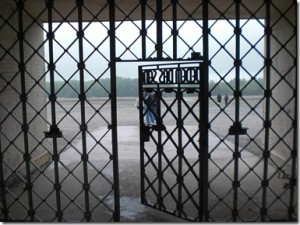
The front gate at Buchenwald, from the inside looking out, that Wiesel says he marched right up to “tens of times” but was always turned back!
- Liberation brings Freedom and Revenge
UdV, P 244: The first gesture of freedom: the starved men made an effort to get something to eat. They only thought about food. Not about revenge. Not about their parents. Only about bread. And even when they had satisfied their hunger—they still did not think about revenge.
SR, P 115: Our first act as free men was to throw ourselves onto the provisions. We thought only of that. Not of revenge, not of our families. Nothing but bread.
Oprah Winfrey interview: Oprah asks, “After you were liberated, what did you do?” Wiesel answers: “The first thing many of us did was reassemble to say a prayer for the dead.” (page 5)
* * * *
UdV, P 244: Early the next day Jewish boys ran off to Weimar to steal clothing and potatoes. And to rape German girls [un tsu fargvaldikn daytshe shikses]. The historical commandment of revenge was not fulfilled.
LN, P 178: Le lendemain, quelques jeunes gens coururent à Weimar ramasser des pommes de terre et des habits—et coucher avec des filles. Mais de vengeance, pas trace.
SR, P 116: On the following day, some of the young men went to Weimar to get some potatoes and clothes—and to sleep with girls. But of revenge, not a sign.
MW, P115: The next day a few of the young men ran into Weimar to bring back some potatoes and clothes—and to sleep with girls. But still no trace of revenge.
In this case, Wiesel made the change from ‘rape’ to ‘sleep with’ in La Nuit. The expression for “German girls” that we find in the Yiddish book was also removed. The term that was actually used is shikses, a word which originally meant “abomination” and which is used today as a term of contempt for all non-Jewish women. In other words, in saying daytshe shikses, the author was expressing, in rather vulgar terms, his contempt and hatred for German women. This apparently was not good for the eyes of the Goyim to see. It was changed by Wiesel in the French La Nuit, and thus it never reached our eyes until now.
Yet, the Yiddish author goes even further and decries the failure of the Jewish males to take a proper revenge, which is here envisioned as a much larger public act of retribution than the “too mild” raping of German women. (Public retribution, of course, did come later with the Nuremberg Military Tribunals.)
Eliezer is hospitalized for two weeks—April 14 to April 28
UdV P 244: Three days after liberation I became very ill; food-poisoning. They took me to the hospital and the doctors said that I was gone. For two weeks I lay in the hospital between life and death. My situation grew worse from day to day.
SR P 116: Three days after the liberation I became very ill with food poisoning. I was transferred to the hospital and spent two weeks between life and death.
MW P 115: Three days after the liberation of Buchenwald, I became very ill: some form of poisoning. I was transferred to a hospital and spent two weeks between life and death.
Three days after liberation on April 11th is April 14th. Thus, Eliezer is in the hospital from April 14 until April 28—extremely ill, close to death. In his 1995 memoir, All Rivers Run to the Sea, Elie Wiesel claims that on that day (the 14th) he was thrown a can of lard, which he apparently ate although he doesn’t remember doing so. He lost consciousness and awoke in a hospital. But the addition of this story, which is in the original Un di velt, presents serious problems for Elie Wiesel. Perhaps the hospital story had slipped his mind when he decided to claim he was one of the survivors lying on a bunk in the “famous Buchenwald liberation photograph.” Because he was in the hospital …
He cannot be in the famous Buchenwald liberation photo taken on April 16 …
I have already demolished the false claim that Wiesel is in that photograph here. But on top of that, our translator found an interview of Leo Eitinger, a Jewish Czech-born psychiatrist, by Harry James Cargas, a friend and biographer of Elie Wiesel, which contained this gem:
HJC: The same thing happened with Livia Rothkirchen at Yad Vashem as happened with you. I was there doing research on atrocity photography for my book A Christian Response to the Holocaust and saw a photo that covers a large wall, of seventeen men lying in their bunks at liberation time. I think you’ve probably seen this picture. Wiesel and Dr. Rothkirchen passed it by many times, over a several-year period, before he told her he was in that photograph. I asked Elie if I could write something about it and he said, “No.” I wrote something and showed it to him and he gave me permission to publish it.
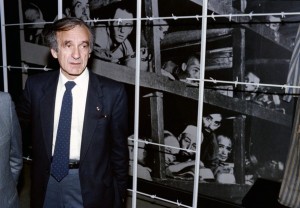
The photo at Yad Vashem in Israel with Elie Wiesel posing in front of it in 1986 after receiving the Nobel Peace Prize in Oslo.
LE: I didn’t know Elie is in the photo.4
Cargas’ book was published in 1993, ten years after it was publicly announced that Elie Wiesel was in that photograph. Apart from the revelation that Cargas has to ask permission from Wiesel before he publishes anything about him, can you imagine that after walking by that famous photo for several years, Wiesel would finally think to say, “Oh hey, that’s me laying there, back in the shadows.”
He cannot have been present to agree to and sign the Military Questionaire on April 22 …
Much has been made by holocaust historians like Kenneth Waltzer and others I won’t name that this Fragebogen made out for Lázár Wiesel proves that Elie Wiesel was in Buchenwald. The birth date is not Elie’s; the date of arrest is not Elie’s; the signature is not Elie’s; the registration number belongs to another prisoner (Pavel Kun) who died only a month earlier; and on top of all that … Elie himself tells us in Night that he was lingering between life and death in the hospital on April 22. He was still six days away from having recovered enough to leave the hospital.
He cannot be in the photograph of the “Boys of Buchenwald” taken on April 27.
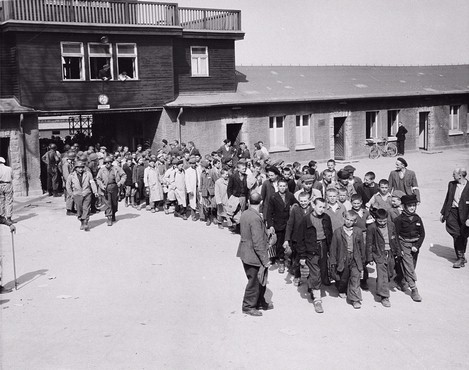 Kenneth Waltzer also claims on his Michigan State University website that Elie Wiesel is “seen to the left” (short boy fourth from the front in left row wearing dark suit in front of the taller boy wearing a beret) in this photograph of the youths being transferred from the barracks inside Buchenwald to the former SS barracks on the outside. Why is Waltzer not paying attention to what is written in Night — that Eliezer was put in the hospital on the 14th of April, at death’s door, and remained for two weeks? One really has to wonder at the stupidity of holocaust historians. Or more likely — how stupid they think the rest of us are! See The Many Faces of Elie Wiesel.
Kenneth Waltzer also claims on his Michigan State University website that Elie Wiesel is “seen to the left” (short boy fourth from the front in left row wearing dark suit in front of the taller boy wearing a beret) in this photograph of the youths being transferred from the barracks inside Buchenwald to the former SS barracks on the outside. Why is Waltzer not paying attention to what is written in Night — that Eliezer was put in the hospital on the 14th of April, at death’s door, and remained for two weeks? One really has to wonder at the stupidity of holocaust historians. Or more likely — how stupid they think the rest of us are! See The Many Faces of Elie Wiesel.
The book’s ending: What does the long passage in Un di velt hot geshvign tell us?
UdV P 245: One fine day I got up—with the last of my energy—and went over to the mirror that was hanging on the wall. I wanted to see myself. I had not seen myself since the ghetto.
From the mirror a skeleton gazed out.
Skin and bones.
I saw the image of myself after my death. It was at that instant that the will to live was awakened.
Without knowing why, I raised a balled-up fist and smashed the mirror, breaking the image that lived within it.
And then—I fainted.
From that moment on my health began to improve.
I stayed in bed for a few more days, in the course of which I wrote the outline of the book you are holding in your hand, dear reader.
But—
Now, ten years after Buchenwald, I see that the world is forgetting. Germany is a sovereign state, the German army has been reborn. The bestial sadist of Buchenwald, Ilsa Koch, is happily raising her children. War criminals stroll in the streets of Hamburg and Munich. The past has been erased. Forgotten.
Germans and antisemites persuade the world that the story of the six million Jewish martyrs is a fantasy, and the naive world will probably believe them, if not today, then tomorrow or the next day.
So I thought it would be a good idea to publish a book based on the notes I wrote in Buchenwald.
I am not so naive to believe that this book will change history or shake people’s beliefs. Books no longer have the power they once had. Those who were silent yesterday will also be silent tomorrow. I often ask myself, now, ten years after Buchenwald:
Was it worth breaking that mirror? Was it worth it?
SR P 116: One day I was able to get up, after gathering all my strength. I wanted to see myself in the mirror hanging on the opposite wall. I had not seen myself since the ghetto.
From the depths of the mirror, a corpse gazed back at me.
The look in his eyes, as they stared into mine, has never left me.
MW P 115: One day when I was able to get up, I decided to look at myself in the mirror on the opposite wall. I had not seen myself since the ghetto.
From the depths of the mirror, a corpse was contemplating me.
The look in his eyes as he as he gazed at me has never left me.
The difference in length between the Yiddish and the English passage is the first thing that strikes us. The Yiddish writer had a lot to say in these final thoughts. He regained his “will to live” right there in the hospital. Twice he speaks of writing an outline and notes for Un di velt hot geshvign while still in his hospital bed. But there is no record by Elie Wiesel anywhere that says he did any writing in preparation for writing his “testimony” while in the camp (in fact, just the opposite), or at any time in advance of 1954.
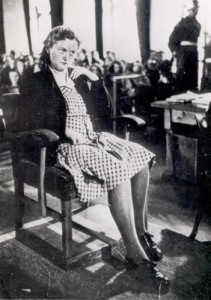
Ilse Koch on the witness stand in 1947. She was seven months pregnant and the only woman brought before the American Military Tribunals held at Dachau.
The tragic true story of Ilse Koch is that she gave birth to one child while a prisoner of the Americans but she certainly was not allowed to raise him. She was hounded, vilified and persecuted after the war, retried by a German court in 1951 after being acquitted at the IMT, and ultimately given a life sentence—solely, it can be argued, to satisfy Jewish vengeance. She committed suicide in prison in 1967.
The Yiddish author also mentions the “six million Jewish martyrs” … in 1954. This number emerged from the Nuremberg Tribunals, but we know that claims of “six million Jewish victims” goes all the way back to the 1890’s.
All this and more was cut out for the French La Nuit (which, remember, was written by Wiesel) and the English versions which were taken from the French. As has been noted by Jewish commentators themselves, the Yiddish writer is an angry, politically-minded religious Jew who expected, or wished, the world to have been transformed by the travail of the Jews during WWII. He is bitterly disappointed. There is more in this final chapter of the Yiddish book that doesn’t appear in the French or English versions. Here is just one passage:
Dreams of truth, of freedom are false dreams for men. Visions of justice and equality are false visions for men. Man is: the struggle for bread, for meat; man is: the struggle to satisfy one’s own instincts.
Man is instinct to the core. Flesh to the core. And not heart. And not spirit. And not morality.
I learned that in Buchenwald. And what one learns in such conditions is without a doubt the truth, the purest truth. For man can really know man only in extreme conditions, when he has thrown away from himself all masks, social and psychological, and appears before us naked, as he is in truth.
In Buchenwald I saw the true face of man. The face of a human animal, which is worse than a true animal. O God, woe is you, woe is man, how trifling and puny. Ought you to even exist, if the son of Adam was made in your image!
God . . . I had ceased to believe in his existence. But despite that, I continued to believe in his evil. (UdV, P 240-41)
Was this written by Elie Wiesel? If it was, he is a man who has put on his own mask to play the game of Jewish vengeance against the goyim persecutors of his people. In other parts of Night, Wiesel writes of losing his faith in a caring God, of no longer following his religion—but later he denied that is true, even though he wrote it! But this passage in Un di velt is too passionate to dismiss as merely a passing sense of discouragement. That is, of course, unless it is just a literary construct and doesn’t reflect any truth of the author.
What does it all mean?
The title of this two-part article is “What Changes were made to Elie Wiesel’s Night, and Why.” I didn’t promise to solve the mystery of the author of Un di velt hot geshvign, but I did hope I might do so, or at least eliminate some contenders.
I confess I expected there to be more difference between the Yiddish and the French books than it turns out to be. It is now clear that La Nuit was taken directly from Un di velt, although that doesn’t mean they were written by the same person. However, that is the greater likelihood unless it can be proven otherwise. Similarly, if Elie Wiesel is the author of Un di velt, it doesn’t mean he was in the camps. The fact that the books are filled with errors argues against it.
Night is a novel
It’s difficult to come to any certainties when the material we have to work with is so internally inconsistent and when there are several versions of it—similar in some ways to the many versions of the Anne Frank Diary. But we can conclude for certain that Night only works as a novel, not as an autobiography—no matter how much the Jewish spin doctors say that a memoir, to be a work of “great literature,” must include some fictional flights of fancy. Nowhere does Night fit the facts. Even with wife Marion’s changes in 2006, it couldn’t be pulled together enough to make a convincing true-life testimony. And we know how many of these “survivor novels” there are around. It’s not like many other hopefuls didn’t have the same idea!
The Lazar-Lázár Riddle
In spite of all the above, I would like to propose a hypothetical scenario, one that I am not endorsing, for obvious reasons, but that does have the value of answering one of the more ignored aspects of this riddle, namely the way the 32-year-old Lazar Wiesel disappeared at the same time the 16-year-old Lázár Wiesel appeared. This cannot be denied. Thirty-one-year-old Lazar arrived at Buchenwald in January; sixteen-year-old Lázár left there in July. The easiest explanation for this is that Lazar wanted to have the papers of a 16-year-old Buchenwald orphan so he could be sent to France. In the confusion of the last months of the war and the immediate post-war period, this kind of thing became more possible. Such an explanation may sound a little far-fetched, but is it any harder to swallow than Elie Wiesel not having the tattoo (Auschwitz ID number) that he says he has? Or Elie Wiesel not having his own Buchenwald identification number, but “borrowing” a dead man’s (Pavel Kun, 2 years older than Elie) right before, or after, liberation? These things don’t make sense. Nor does the fact that in La Nuit Elie Wiesel wrote that his father died on Jan. 28, 1945, while in the Yiddish book that he also claims to have written as his own “testimony” the date is Feb. 2nd? Or that he wrote that the Russian Army took over the Auschwitz complex two days after its evacuation, which everyone knows is false?
Elie Wiesel even wrote in Night that his foot was operated on right before the evacuation of Auschwitz, while in his later real memoir, All Rivers Run to the Sea (pp 89-90), he flat-out recalled it as his knee, something that could not be mis-remembered. I could list many of these senseless “mistakes,” many of which I have written about in earlier articles.
There is something that doesn’t fit well into this Lazar-Lázár hypothesis, though—that is, that we have pictures of the real Elie Wiesel in France at the Jewish welfare orphanage, OSE. But how did he get through a year at Auschwitz and Buchenwald with no records of his being there … and a poor memory of what occurred and when? Did he somehow manage to attach himself to the Buchenwald transport with the stolen identity papers? But also, there are other ways he could have come to be at the Ecouis homes in France than in the children’s transport from Buchenwald. Just as there are other ways he could have come into possession of the Yiddish Un di velt without writing it himself.
Was Elie Wiesel in the camps?
My answer is still no. Wiesel could have been in some camps in some capacity under some auspices, but he is not telling the truth about what camp experience he did have. That means Hilda Wiesel Kudler is also not telling the truth but is standing by her brother. She says at the end of her bitter testimony to the Shoah Foundation, “I will not forget, and I will not forgive.” Have you ever wondered why Elie has not contributed a videotaped testimony to the Spielberg/USC Shoah Foundation library?

Elie Wiesel with his older sisters Bea (left) and Hilda (right) in Paris after the war, exact date unknown.
Wiesel’s other sister, who changed her name to Beatrice from Batia, never wrote or testified a word about it. She did go to work for Jewish organizations in Germany, however, immediately after the war, helping Jews to emigrate to wherever they wanted to go, including Palestine. The whole family were committed Zionists, as were most Eastern European/Russian Jews who were able to flood into the West because of the war. ‘Bea’ finally got her own papers to emigrate to Canada.
A Jewish organization, Sharit Ha-Platah, gathered names of Jews who were liberated from Dachau and it’s many sub-camps and published them in 1946. This is the only record so far found with the names of Hilda and Beatrice Wiesel, and it is a self-identified list of Jews by Jews, not an official German record of forced laborers or prisoners. So the hard evidence for the Wiesel family is not there. It doesn’t mean they weren’t, however; it’s just that we’re left with believing what they say, because we want to or because we’re expected to.
The easiest option is to go along with Elie Wiesel’s story that he was in those camps, and question his credibility from other angles, such as the in-credible stories he tells. This is what revisionists had done before Nikolaus Grüner came along and released documents he had obtained from Buchenwald and the correspondence he had with the archivists there. These documents cannot be ignored, in spite of what other nonsense Grüner writes in his book Stolen Identity. These documents have caused a sea change in revisionism about Elie Wiesel, to the extent that it can be divided between pre-Grüner and post-Grüner research and writing.
Wiesel needs to expose himself to questions
Because of these documents, it is up to Elie Wiesel to come forth and answer questions about them. But being that he is completely unprepared to do so, this job has been given to his surrogates—Professor Waltzer for one. Kenneth Waltzer promised, with a lot of bombast, that he would produce proof that Elie is Lazar and that Shlomo is Abraham, but for a year now he has failed to produce it, or even say anything more about it. He has also failed to come out with his promised book, “The Rescue of Children and Youths at Buchenwald,” which was to include Elie Wiesel. In the opinion of this writer, Waltzer is as big a fraud as Wiesel, selling emotion and sentimentality instead of factual history. They are both supported with professorships at well-funded universities.
So, back to the main question: Was Elie Wiesel in Auschwitz and Buchenwald? As I said, my answer is still no … and no one should accept that he was without some further explanation from him, during which he subjects himself to questions. If he’s genuine, he can certainly withstand questions. That, however, is not going to happen because … fill in your own answer.
Elie Wiesel has kept the details of his life before 1955 vague. He has managed to prevent unwanted questions from being asked of him. He hides behind a stated aversion to “holocaust deniers” so that anyone who is not a 100% believer is not welcome in his company. He gets away with the ‘moral outrage’ he professes toward anyone who doubts, thus no interviewer, reporter, writer, academic, student or even President dares to doubt in his presence. It works like a charm.
Endnotes
1. Danuta Czech, Auschwitz Chronicle: 1939-1945. New York: Henry Holt, 1997
2. APMO, D-Bu 3/17, pp. 18-85, 87 (transport list as cited by Czech in Auschwitz Chronicle)
3. Hilda was obviously unaware that the march itself was only 24 hours, probably because she had heard so many false and exaggerated stories about “endless days of marching” that proliferate in survivor stories.
4. Harry James Cargas, ed. Voices from the Holocaust, Lexington: University of Kentucky Press, 1993. pp. 116-22.
7 Comments
Category Featured | Tags: Tags: Auschwitz-Birkenau, Buchenwald, Elie Wiesel, Hilda Wiesel, Holocaust fraud, Miklos Grüner, Night, Shlomo Wiesel, Un di velt holt geshvign,
Social Networks: Facebook, Twitter, Google Bookmarks, del.icio.us, StumbleUpon, Digg, Reddit, Posterous.
Thursday, February 2nd, 2012
By Carolyn Yeager
New information has come to the attention of this site about the Yad Vashem “Page of Testimony” (PoT) filled out for Shlomo and Mendel Wiesel by their cousin Yaakov Fishkowitz in 1957.
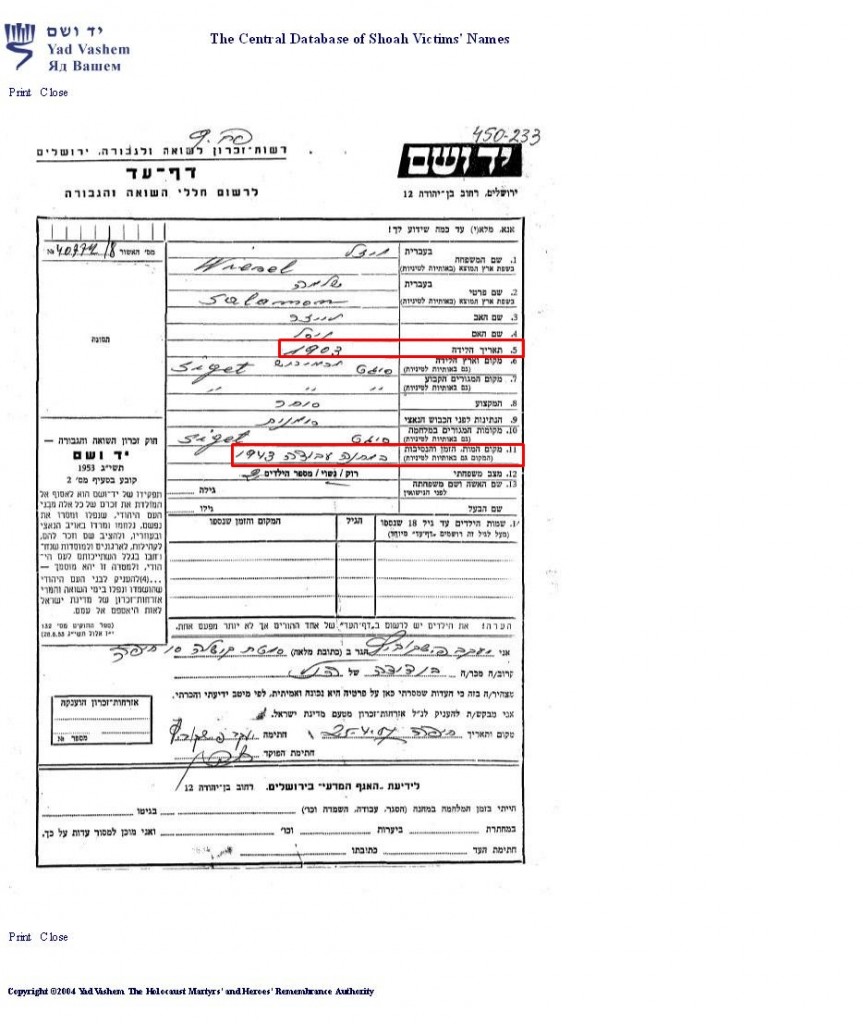
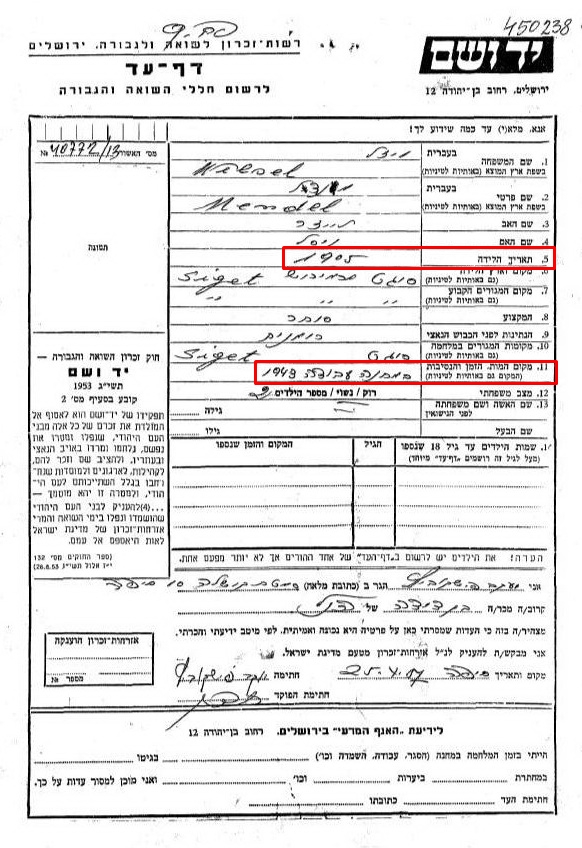
Our previous description of these pages was done without knowledge of Hebrew; thus we erred in one instance dealing with the place of death of Shlomo and his brother Mendel Wiesel. Note on the forms above that “Sighet,” on line 10, refers to the “Place of residence during the war,” not to the place where death occurred.
Going to line 11, the instructions written in Hebrew on the right of the page read (right to left):
11. Place of death, time and circumstances (Place also in Latin alphabet).
To the left of that Fishkowitz has written (also right to left): in camp / labor / 1943
This gives quite a different picture than we had before! According to Yaakov Fishkowitz, his cousins Shlomo and Mendel Wiesel were both in a camp performing labor in 1943, where they both died in that year. Fishkowitz obviously did not know what camp. Sighet was located right on the border with what had been Czechoslovakia, but was at that time more of Hungary until 1945. [See map in Shadowy Origins of Night II] Today, that area is Ukraine, and Sighet is once again in Romania. If the brothers had gone north on some kind of mission, toward Poland, they could have gotten arrested and placed in a camp as labor. But, in any event, Fishkowitz may not have had actual information that they died, only that they didn’t come back to Sighet and he didn’t see them again. The same goes for all the rest of his family—they were deported to Auschwitz, he says, and he never saw them again … so he declared them dead. But what about Yaakov Fishkowitz, himself? Was he also at Auschwitz? Why did he survive?
What kind of credibility can we assign to Yaakov Fishkovitz?
Fishkowitz filled out ten pages of testimony (PoT’s) on the same day, April 25, 1957, for ten relatives. Of the ten, only the two brothers were said to have died in 1943. All the others, including his aunt Nisel Wiesel, Shlomo and Mendel’s mother, he presented as perishing in 1944, all but one at Auschwitz. It doesn’t seem that he would have differentiated a totally different fate for Shlomo and Mendel if he didn’t have reason to think that it was different.
According to Fishkowitz, seven members of the Basch and Fishkowitz family died at Auschwitz in 1944—two uncles and a cousin, Naftuli Basch, 39 yrs.; Nisel Basch Wiesel his aunt, 64; his mother Mentza Basch Fishkowitz, 65; his father Fishel Fishkowitz, 66; his 29-year-old sister Shewa Fishkowitz Kohen. Yaakov’s 20-year-old brother Shlomo Fishkowitz died in 1944 “at labor” but Auschwitz is not mentioned. Could he have been one of the young men who were taken off to work on infrastructure construction for the Germans?
Yaakov’s father was born in Strimtura, another town in the Maramures district. His mother was born in Sighet but lived in Strimtura after her marriage and their children were born there. In 1944, only his father, mother and younger brother Shlomo lived in Strimtura; the other seven relatives who “died” lived in Sighet, which was clearly the “big city” of the district. Was Yaakov living in Sighet at that time, too? When he filled out the PoT’s in 1957 he was in Haifa, Israel, which he listed as his permanent address. Did he leave for Israel immediately after the “liberation” and have difficulty tracking down his family members after that?
According to Yaakov, not only the old, but the young and those in the prime of life were murdered! Why was the 14-year-old Elie Wiesel spared from “extermination” by claiming to be eighteen1, but his 20, 29 and 39-year-old relatives were not spared? And why would 20-year-old Shlomo Fishkowitz die from “labor” when 14-year-old Elie Wiesel did not? Wiesel’s two sisters, age approximately 19 and 22, were sent to a work camp affiliated with Dachau and survived. Shewa, Yaakov’s 29-year-old married sister, is said to have been a seamstress. Surely the SS could have found plenty of work for her to do, and no doubt did! At Auschwitz, there was a workshop full of sewing machines where female inmates constructed German military uniforms, along with whatever other sewing projects were carried out.
Another legitimate question is why some of these relatives were not met by Shlomo and Elie early on during their stay at Auschwitz but relatives Asher Stein and Hersh Genud, plus hometown friend Meir Katz, are?
[In fact, if Hilda and Batya Wiesel stayed at Auschwitz until August ’44 (according to Hilda’s testimony), wouldn’t their father and brother have gotten word of it—in the same way that Asher Stein learned that Shlomo and his son Eliezer were there, even before they were transferred to Monowitz (that is, in the first 3 weeks)? In Night, Stein was always seeking word of his family; others do also, but Shlomo and Eliezer never once mention those two daughters/sisters after arrival.]
Elie Wiesel tells of father’s imprisonment in his memoir
When Elie Wiesel filled out a Page of Testimony for his father in 2004 at the Yad Vashem Memorial in Israel, at the request of Avner Shalev, Chairman of the Yad Vashem Directorate, it was filmed as a publicity tool to persuade more Jews to submit these PoT’s. (see film here). In the short film, Wiesel mentions briefly that his father had been arrested and detained for a spell. He said more about this in his memoir, All Rivers Run to the Sea, writing that his father was arrested for helping Polish refugees and “spent weeks in prison, first in Sighet, then in Debrecen,” and was released because of help from “his friends in Budapest.” Wiesel fails to give a date for this. It all takes place in Hungary, however, not in Poland. But Hilda Wiesel doesn’t mention it at all in her Survivors of the Shoah testimony.
Was this what became a “camp” to Yaakov Fishkowitz? When he heard that Shlomo Wiesel was dead, did he put it together in his own mind later that his cousin died during that short imprisonment? But why include Mendel in the event; he was not included by Elie. If Yaakov Fishkowitz’ testimony is completely wrong, it means no PoT at Yad Vashem is worth the paper it’s written on. Even Elie Wiesel’s PoT for his father does not include a birth date, though a Yad Vashem representative was sitting right there with him (as seen in the film) and should have encouraged Wiesel to complete the form fully! I’m being a bit facetious here. Does not a son know his father’s date of birth? In Night, Elie wrote that Shlomo is 50 years old—in 1944. So why didn’t he use that on the PoT?
Another point is: wouldn’t the Page of Testimony by Fishkowitz for Elie’s father have been shown to Elie Wiesel? Would they not have searched through the testimonies to find what had been submitted for Wiesel’s family? I’m sure they did. Both PoT’s cannot be correct! Yet they both remain in the database. This is a serious criticism of the integrity of the Yad Vashem Memorial and of the Elie Wiesel support team.
As we know, a distinctive feature about the Elie Wiesel story is that there is no consistency to it and no one seems to want there to be any.
In 1957, no book had yet appeared
Yaakov Fishkowitz was not writing these Pages of Testimony to fit in with a book written by Shlomo’s son. We don’t know his reasons for writing what he did, but he would not have been concerned with fitting in with any particular family story. He probably put down what he thought had happened to these persons, given the political atmosphere of the time, or what he wanted the world to believe about them. All I can say is: He did place Shlomo Wiesel and his brother in a labor camp in 1943, and said they had died there. If true, Elie Wiesel’s story is completely fabricated, or based on someone else’s story.
More serious discrepancies will be brought forth in the next article. Stay tuned.
Endnotes:
1. Elie Wiesel, Night, 1960, p. 41. “How old are you?” he asked, in an attempt at a paternal tone of voice. “Eighteen.” My voice was shaking.
3 Comments
Category Featured | Tags: Tags: Elie Wiesel, Mendel Wiesel, Shlomo Wiesel, Yad Vahshem Database,
Social Networks: Facebook, Twitter, Google Bookmarks, del.icio.us, StumbleUpon, Digg, Reddit, Posterous.
Friday, December 23rd, 2011
by Carolyn Yeager
copyright 2011 carolyn yeager
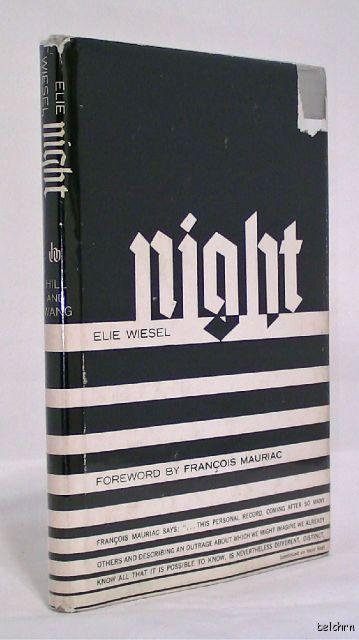 Why is Grandma Nisel not mentioned in Elie Wiesel’s Night?
Why is Grandma Nisel not mentioned in Elie Wiesel’s Night?
According to Hilda Wiesel’s 1995 “Survivors of the Shoah” testimony, Grandmother Nisel (also spelled Nissel) went with the family to Auschwitz.
According to Elie Wiesel’s 1995 memoir, All Rivers Run to the Sea1, Grandmother Nisel went with the family to Auschwitz.
But Grandma Nisel is not mentioned even once in Wiesel’s 1958-60 supposedly autobiographical Night.2
Did Wiesel simply forget about his grandmother only 10 years after the event and then remember her again in the 1990’s? Did he cut her out because he wanted to condense his book and she was peripheral to the storyline? Neither of these can be believed. In the first place, Wiesel makes it clear in All Rivers how important Grandma Nisel was to him and he writes affectionately about her. Secondly, by including his grandmother when he mentioned his mother and three sisters, he would not have added more than a few words to the deportation narrative, as we will see. Thirdly, Grandma Nisel, as a member of his family group that he says he lost at Auschwitz, could not with any decency be left out when writing about this momentous event.
And, in fact, he didn’t leave her out of his memoir, nor did Hilda leave her out of her testimony. But Night is another story (pun intended).
There is no excuse or explanation that can be given for such a lapse, and none has ever been attempted. Not one of Wiesel’s numerous interviewers, biographers, commentators or adulators have ever asked about it, or, if they did, they must have accepted without complaint a “no comment” from him. (I suspect that whenever Wiesel gives an interview or allows someone to write a book about him, he obtains an agreement in advance as to what can be discussed and what is off-limits. And I imagine probing questions about his family are off-limits … probably on the grounds that it is “too painful” for him. Wiesel is always treated with the softest of kid gloves.)
Who is Grandmother Nisel and why is she important?
Nisel Bash was the daughter of Moshe and Yehudit (or Mindil) Bash (or Basch). She was born in 1881 in Chust, Ruthenian-Czechoslovakia. She married Eliezer Vizel and lived with him in Sighet, Rumania … which later became Hungary. (This information is from the victim forms filled out for Yad Vashem by her nephew and grandson; see further below.) We don’t know the date of her marriage, but her first child may have been born in 1900 when she was 19 years old. This first child of Nisel and Eliezer was probably a daughter, either Idiss or Giza. In 1903 their first son, named Shlomo, was born. After that came another son, Mendel; then two more daughters.
Below: YV forms for Shlomo Wiesel by Son Eli and cousin Yaakov Fishkovitz. (click on picture for larger image) Below that is the 1957 YV form for Mendel Wiesel by Yaakov Fishkovitz.
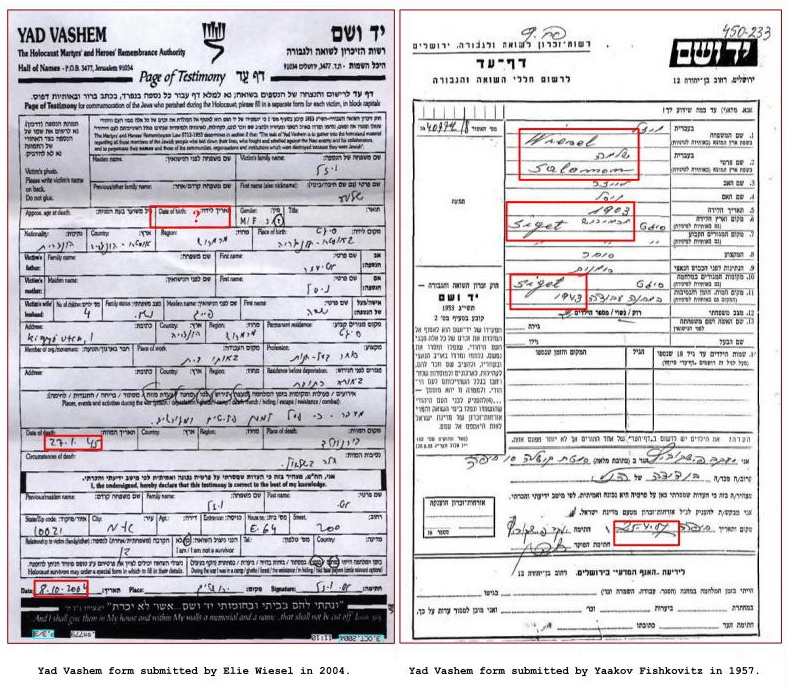
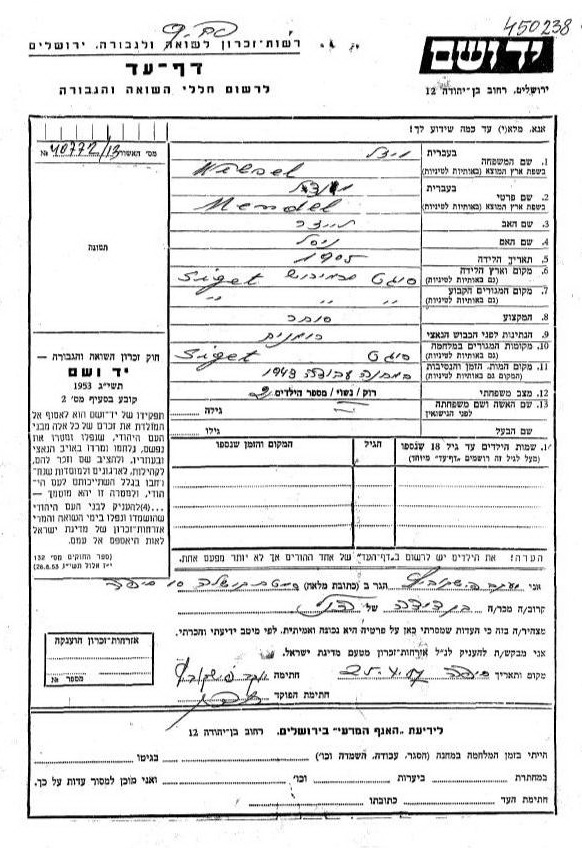 I have reconstructed the birth dates of Nisel’s children as best I can since no reliable family genealogy has ever been made available. Sites like Rootsweb are completely useless for information about the Wiesel family. In All Rivers (p. 7), Elie Wiesel writes about his aunts:
I have reconstructed the birth dates of Nisel’s children as best I can since no reliable family genealogy has ever been made available. Sites like Rootsweb are completely useless for information about the Wiesel family. In All Rivers (p. 7), Elie Wiesel writes about his aunts:
“I also had two aunts in Czechoslovakia: Aunt Idiss in Slotvino and Aunt Giza in Ungvaer. Grandma Nissel’s other two daughters lived in Sighet. Zlati, the youngest, was called an old maid behind her back. She married late, you see—at twenty-one.”
The older of the two daughters who lived in Sighet is never named or described, yet she could not have died as a child since Wiesel speaks of her as living in Sighet when he was a boy. Did she disgrace the family in some way and so is not to be mentioned? Wiesel writes that Grandma Nisel sat at the cash register in his father’s store, but also helped out at her son Mendel’s store:
“Maybe (Grandma Nisel) was trying not to show favoritism toward any of her children. My father was the oldest, but she was just as close to my Uncle Mendel, who had a modest grocery store on the other side of town.”
From this we can understand that Shlomo was the oldest of the two sons. Among Orthodox Hasidic Jews, males are in an entirely different category of importance and expectations than females, who are only required to find a good husband and have children. Mendel married Golda Feig, the sister of Sarah Feig, making for a tight-knit Wiesel-Feig family relationship.
Uncle Mendel Wiesel was born in 1905, according to cousin Yaakov (the only source we have) and died at the same time as Shlomo in 1943. He would have been only 38 years old! Yet in Night he appears in the story at the time of the deportation to Auschwitz—Elie Wiesel’s family stays in his empty house in the small ghetto. On page 30:
“The people must have been driven out unexpectedly. I went to see the rooms where my uncle’s family had lived. On the table there was a half-finished bowl of soup. There was a pie waiting to be put in the oven. Books were littered about on the floor. Perhaps my uncle had had dreams of taking them with him?”
Nisel lived in her own house that was close to her son Shlomo’s home. Young Elie dropped in often to visit her and had quite a few stories to tell about that in All Rivers. Elie’s namesake grandfather Eliezer had been killed in the First World War in his capacity as a stretcher-bearer. Nisel related to her grandson that when she was told of his death: “I learned what catastrophe meant, and I knew my mourning would never end.” (All Rivers, p 8)
On page 9, Wiesel relates a story that when he returned to Sighet as an adult, he first went to the cemetery to find his grandfather’s grave. He spoke to his grandfather’s spirit about the deportation to Auschwitz thus: “Did you know, Grandpa, that Grandma Nisel was the only one in the family, almost the only one in the whole community, who guessed it all? She knew she would never come home. She left this wretched town in her funeral dress. Yes, she wore her shroud under her black dress. She alone was ready.”
There are two other distinct mentions in All Rivers of his grandmother taking part in the deportation-to-Auschwitz process. On Page 70 he writes that on Tuesday, May 16, they were ordered out of their houses to be sent to the small ghetto. “There was another heat wave. My little sister was thirsty, and my grandmother too.” Page 77, arriving at Auschwitz: “I stared intently, trying desperately not to lose sight of my mother, my little sister with her hair of gold and sun, my grandmother, my older sisters.”
Yet in 20 pages in the book Night of detailed description of the pre-deportation events, the trip to Auschwitz and their arrival, there is no mention at all of a grandmother. Nowhere in the entire book is there a Grandma Nisel.
Other family members place Grandma Nisel at Auschwitz.
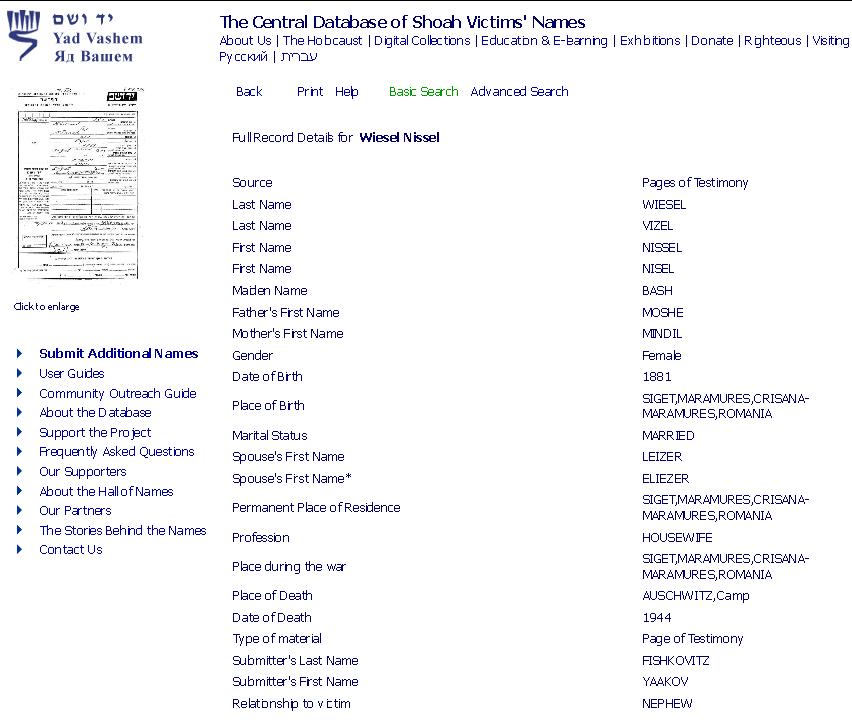
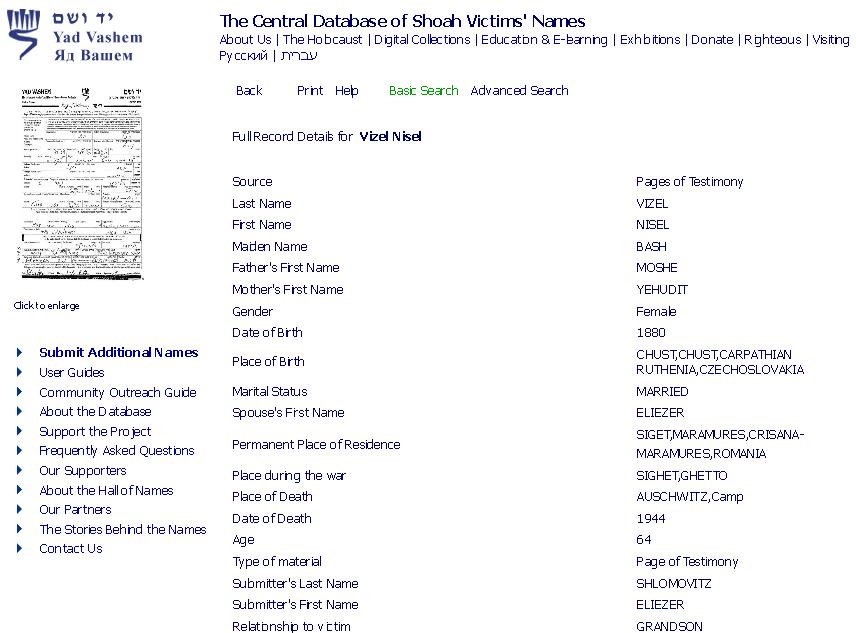
Her nephew Yaakov Fishkovitz in 1957 filled out a YV form (above top) stating she died at Auschwitz in 1944. Yaakov also filled out a form for his cousin Shlomo Wiesel. A grandson, Eliezer Shlomovitz of Los Angeles CA, filled out a Yad Vashem form for his grandmother Nisel Vizel too, many years later in 1994 or 1999 (hard to read), saying she died at Auschwitz in 1944 (above). But neither Elie nor his two surviving sisters acknowledged her death at Auschwitz in this way. Although Hilda said in her 1995 Shoah testimony: “… we were, myself and my sister, the one who was in Canada and is now deceased; my mother; my grandmother, that is my father’s mother; and, oh . . . my little 10-year old sister.”
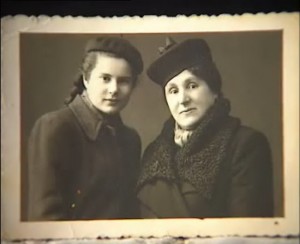 Hilda also said: “And my mother – died. She was 44 years old.” She then repeated: “And my little sister – dead at age 10.” These are assumed deaths. But if she is correct about her mother’s age in 1944, then Sarah Feig was born in 1900. Could she have been 3 years older than her husband, born in 1903 according to his cousin Yaakov? Possibly, even considering what we know about Hasidic marriages, wherein the groom is usually no more than one year older, or the same age, as the bride.3 But Hilda, being the eldest, should know her mother’s age. Right: Hilda, age 16, in 1938 with her mother Sarah Feig Wiesel, who would have been 38 in the picture if she were born in 1900.
Hilda also said: “And my mother – died. She was 44 years old.” She then repeated: “And my little sister – dead at age 10.” These are assumed deaths. But if she is correct about her mother’s age in 1944, then Sarah Feig was born in 1900. Could she have been 3 years older than her husband, born in 1903 according to his cousin Yaakov? Possibly, even considering what we know about Hasidic marriages, wherein the groom is usually no more than one year older, or the same age, as the bride.3 But Hilda, being the eldest, should know her mother’s age. Right: Hilda, age 16, in 1938 with her mother Sarah Feig Wiesel, who would have been 38 in the picture if she were born in 1900.
The name Shlomo appears only once in Night at the end.
On the very first page of this famous novel it is written: “My father was a cultured, rather unsentimental man.” Right here it would have been natural to write: My father, Shlomo Wiesel, was a cultured, rather unsentimental man. But no, and throughout the book this character continues to be known only as “my father,” until page 103-4 when another prisoner, Meir Katz, addresses him by his first name. In the original edition it is spelled Chlomo; in the 2006 translation, the spelling is changed to Shlomo. The name of Wiesel also occurs only once, on page 51:
We had already been eight days at Auschwitz. It was during roll call. We were not expecting anything except the sound of the bell which would announce the end of roll call. I suddenly heard someone passing between the rows asking, “Which of you is Wiesel of Sighet?
The man looking for us was a bespectacled little fellow with a wrinkled, wizened face. My father answered him.
“I’m Wiesel of Sighet.”
The little man looked at him for a long while, with his eyes narrowed.
“You don’t recognize me—you don’t recognize me. I’m a relative of yours. Stein. Have you forgotten me already? Stein! Stein of Antwerp. Reizel’s husband. Your wife was Reizel’s aunt. She often used to write to us … and such letters!”
Let’s remember there were many Wiesel’s (Vizel’s) in Sighet, a town with a large Jewish population. For example, there are three Mendel Wiesel’s from Sighet of around the same age in the Yad Vashem databank, and there are eight Shlomo Wiesel’s recorded as succumbing in the camps. This doesn’t include all the Wiesel’s with other first names! So we can expect that the man Stein would have used the first name too, or Wiesel would have asked Stein which Wiesel he was looking for. This seems like another avoidance of using the name Shlomo, but it is strange that both the first and last name were used one time only.
On page 2, the sisters are named:
There were four of us children: Hilda, the eldest; then Bea; I was the third, and the only son; the baby of the family was Tzipora.
In the original Night (p 31), the family servant, a Christian from a nearby village, is named Martha. In All Rivers, she becomes Maria, and the name in the 2006 re-translation of Night is changed to Maria. Okay, it could have been an error.
The dust jacket on an original, hard-bound copy of Night reads: “The adolescent Elisha and his family, among hundreds of thousands of Jews […] are cruelly deported …” Elisha is not the name of the main character in the book; it is Eliezer. The first time that name is used is on page 86: “Let’s hope that we shan’t regret it, Eliezer.” On page 92: “Don’t let yourself be overcome by sleep, Eliezer.” On page 96, Eliezer is addressed by his name twice by Juliek. On page 108: ”Eliezer … my son … bring me … a drop of coffee…” Then, again, on pages 109, 110 and 112. Why is he called Elisha on the dust jacket? Elisha is the name of the main character in Wiesel’s second novel, Dawn. A little mix-up there?
In Night, Father is 50 and little sister is seven.
In spring 1944, just arriving at Auschwitz, Eliezer’s father declares that he is fifty years of age. Eliezer says he is “not quite 15.” (p 40) In the new 2006 translation (p 30), Eliezer’s age is changed to “15” but the father’s “fifty” remains the same. “Not quite 15” doesn’t equate to Elie Wiesel, whose birthday is Sept. 30, 1928, so that was an oversight in Night. Or it can also be seen as a similar situation as with Tzipora’s age: Making the young victims even younger so they will appear more sympathetic to the reader, and making some adults older. Lying about their age is a tactic used by many “holocaust survivors” in their memoirs to explain how they escaped the “gas chamber.” Arguably, this could have been done by Sarah Wiesel for Tzipora too—claiming her to be 14 instead of 10, since in the story Night, Eliezer made himself out to be 18 (3 years older that he really was) and got away with it.
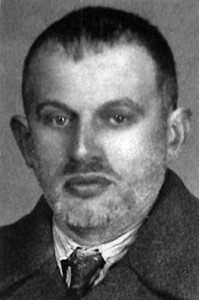 Why is the father in Night fifty? Shlomo Wiesel was certainly somewhere between 40 and 44 years of age in 1944. Actually, according to his cousin Yaakov, he wasn’t even alive, having died in 1943! Moreover, Mendel died in 1943 also. One has to assume from this that they died together somehow. Yaakov filled out a form for Mendel at the same time as for Shlomo. The forms look exactly alike except for the different name and date of birth. Shlomo is shown to be born in 1903, Mendel in 1905. Keep in mind that in 1957 the book Night was not yet published in French or English and the name of Elie Wiesel was completely unknown, so Fishkowitz had no reason to lie to protect his relatives, as he might have had later.
Why is the father in Night fifty? Shlomo Wiesel was certainly somewhere between 40 and 44 years of age in 1944. Actually, according to his cousin Yaakov, he wasn’t even alive, having died in 1943! Moreover, Mendel died in 1943 also. One has to assume from this that they died together somehow. Yaakov filled out a form for Mendel at the same time as for Shlomo. The forms look exactly alike except for the different name and date of birth. Shlomo is shown to be born in 1903, Mendel in 1905. Keep in mind that in 1957 the book Night was not yet published in French or English and the name of Elie Wiesel was completely unknown, so Fishkowitz had no reason to lie to protect his relatives, as he might have had later.
Contrarily, on the Yad Vashem form Elie Wiesel filled out in 2004, no birth date is given for his father, nor the age at death. Did he not know? Is it possible for a son not to know his father’s age?
This photograph (left) of Shlomo Wiesel was taken in 1942 according to Hilda Wiesel. At this time he would have been 39 years old.
Further, we have no information on these details for Wiesel’s mother Sarah Feig either, and no family member (or anyone) ever filled out a YV Holocaust victim form for her or her youngest daughter who supposedly died with her at Auschwitz. (Can the reason be that they don’t want to record an age/birth date for either one?) But, as I wrote above, Hilda Wiesel Kudler said in her Shoah testimony that her mother was 44 years old when she died, and her youngest sister was ten. Is Hilda a reliable witness?
On page 30 of Night, Eliezer says: “I looked at my little sister Tzipora, her fair hair well combed, a red coat over her arm, a little girl of seven.” This is when the family was walking to the ‘small ghetto’ after being ordered out of their home in the spring of 1944, only a week or so before they arrived in Auschwitz. But Hilda said Tzipora was then ten years old. Which is correct? Or is neither? Some of my readers will tell me, “What does it matter?” Accuracy matters, because if a source is wrong in some things that can be determined as wrong, nothing from there should be depended upon.
Nowhere in All Rivers do we find Tzipora’s age given by Wiesel, even though he mentions her many times. He only wants us to know that she was young or “a child.” A ten-year-old girl is quite a bit more mature than a seven-year old. I venture to say she was given the age of seven in Night to make her appear more vulnerable, and her death even more of a barbaric crime. Also, if she were seven, there would be more reason to “exterminate” both mother and daughter, under the extermination thesis. But in truth, a 44-year-old-woman and her 10-year-old daughter could be quite useful in the labor force, and therefore could have gone on to meet some other fate. There may even be some private knowledge of that—which may be another reason no one has filled out a Yad Vashem Holocaust Victim report for these two, while two were filled out for 64- year-old Grandma Nisel.
That Shlomo Wiesel was 50 years old in 1944 can be ruled out by the fact that his mother was 64 years old in 1944, making her only 14 years older than a 50 year old. So this Father character cannot truly be the real Shlomo. The father is depicted as somewhat confused, a poor decision maker, and as having difficulty adjusting to camp life, both physically and psychologically. He appears more like a man of sixty. Eliezer is often shown to be his father’s caretaker. “My father … was running at my side, out of breath, at the end of his strength, at his wit’s end. I had no right to let myself die. What would he do without me? I was his only support.” (Night, p 90)
A fifteen-year-old with a gold crown?
How many 15-year-olds do you know who have a crown on a tooth already? Thirty-one-year-olds may, the age Lazar Wiesel was in 1944. Or the following story could be totally fabricated. Wiesel writes in Night that when he was transferred to Monowitz (Buna), he was given a physical and a dental exam. The dentist wanted to remove his gold crown; Eliezer talked him out of it. One day his work foreman, named Franek, noticed the gold and told Eliezer he wanted it. Eliezer resisted, but eventually, after suffering a series of abuses, gave up his gold tooth to Franek. In this story, he is called out for his dental appointment by his number, “A-7713.” (p 58) The number is used again on page 64 when the Kapo decides to give him a beating.
I felt the sweat run down my back.
“A-7713!”
I came forward.
Earlier, on page 51, the author wrote:
“The three “veterans,” with needles in their hands, engraved a number on our left arms. I became A-7713.”
Yet where is the number A-7713 on Elie Wiesel’s left arm?
At Buna, he worked in an electrical warehouse alongside some Polish civilians and a few French women After his beating by the Kapo, one of the French girls came over to him, “wiped his blood-stained forehead with her cool hand,” gave him a mournful smile and a bit of bread. Finally she spoke to him “in almost perfect German.” Several years later he recognized her in the Paris Metro, and prodded her memory. They went to a terrace café and she revealed to him that she was Jewish, from a religious family, and during the occupation she obtained forged papers and passed herself off as an Aryan. She was enlisted in “forced labor groups” and deported to Germany. That’s how she escaped the concentration camps.
These kinds of stories abound in Night and other holocaust-survivor books. No witnesses, no proofs, no names, just a bit of imagination. I will remind you again that the original Night was published in 1960 categorized as Judaica/Literature … in other words, fiction. When the new translation came out in 2006, it was changed to Autobiography/Jewish Interest. It is now an autobiography of Elie Wiesel, with his picture on the back cover and a special new Preface, written by him, which condemns the Germans and attempts to explain the changes he and his wife have made in the text.
Eliezer Wiesel is not necessarily Elie Wiesel
The author of the Yiddish book is Eliezer Wiesel. The author of Night is Elie Wiesel. There is only 2 years between the publication of Un di Velt Hot Gesvign in 1956 and the French La Nuit in 1958, but in that time the author’s name had changed. When did Elie start being called ‘Elie’ rather than Eliezer or Liezer or Lazar or something else? According to some of his biographers, it was when he was still living at home with his family. As we know, there were many Eliezer Wiesel’s (Vizel’s) in Sighet, let alone in Hungary, at the time. Un di Velt Hot Gesvign, however, was written in Polish Yiddish, or at least it was published in that language. The final version of the book of 245 pages was edited by Mark Turkov who specialized in Polish Yiddish. Where the story came from, we really don’t know. That’s the bottom line. We have the preposterous story told by Elie Wiesel of writing it in a ship’s cabin on his way to Brazil at a time that he was involved in a serious love affair and embarking on an important assignment for his newspaper. Equally preposterous is his claim to have handed an 862-page manuscript over to the stranger Turkov during a chance meeting on the ship, docked at Sao Paulo, without a copy for himself or a contract or any guarantee of return – just ‘good faith.’ Being an experienced journalist at that time, he would certainly have known better. Worse than that, he says he didn’t even believe when he gave it to him that Turkov would publish it. (All Rivers, p 240-41)
We make a leap of faith to believe that Eliezer Wiesel has to be Elie Wiesel. It should also be pointed out that these survivor stories were all the rage within the Yiddish-speaking communities at the time. There were many of them in circulation, even before they were published. Elie Wiesel had cousins in Argentina whom he visited while he was there in April-May 1954; he mentioned them in All Rivers.4 It’s very likely that he was introduced to these survivor stories, and Mark Turkov’s publishing house, through these relatives and their circle. Was he attracted to a particular story by an author with his own name, Eliezer Wiesel?
More unlikely stories
Wiesel tells us another unlikely story in All Rivers (p 277) that in Dec. 1955, back in Paris, he received a copy of the published book, edited down to 245 pages, in the mail from Turkov. There are no witnesses to this. He only mentions telling one close friend, Israel Adler, who took him out for a coffee by way of celebration.(!) Shortly after that he moved to the United States. It appears from his writings that Wiesel forgot all about the manuscript he gave to Turkov until the book came to him in the mail, but he does add on that page that “they never did send back the manuscript”—to give himself a reason for not having it and not being able to say what was actually in it.
In contradiction to this story is the one wherein Francois Mauriac, whom Wiesel first meets in Spring 1955, encourages him to write about his concentration camp experiences. He doesn’t tell Mauriac he has already done so, but acts like he will think about it, later accepting the guilt-ridden, elderly Catholic’s help in getting the book published. Wiesel writes in All Rivers, p 319, that he sent a manuscript of what became La Nuit (Night) to Mauriac one year later, in 1956.
In 1957, during my convalescence, I received good news from Francois Mauriac: Jerome Lindon of Editions de Minuit was going to publish La Nuit (Night). The letter of confirmation opened a new chapter in the book of commentaries that is my life.
Lindon didn’t like the orginal title: “And the World Remained Silent.” He preferred a biblical phrase, perhaps something from the Book of Jeremiah. But after discussing various suggestions, we settled on La Nuit. Lindon also wanted me to tighten the text, given to him by Mauriac, though I had already pruned and abridged it considerably.
The text was given to the French publisher by Mauriac. In the following lines he says that he, Elie, was the one who made the drastic cuts in the original manuscript. When?!
He proposed new cuts throughout, leading to significant differences in length among the successive versions. I had cut down the original manuscript from 862 pages to the 245 of the published Yiddish edition. Lindon edited La Nuit down to 178.
What a tissue of lies. Never before had Wiesel written about the Yiddish book, but now, in 1995, he relates that it was he who cut the 862 pages to 245. Such a prodigious task would certainly not have gone unremarked upon by him! And now it is the publisher Lindon who did the final editing to 178 pages. One wonders just what part Elie Wiesel played in this group effort?
Wiesel continues with an unconvincing “explanation” of why the book’s original ending was cut out, something that was made controversial by a certain Jewish scholar. He then says, “By the time Night was published in France, I was at work on another book.” This rendition of how such an important book came about is so sloppy and insulting to the intelligence of his readers that it speaks for itself.
Both the USHMM and Wikipedia have the dates wrong.
At the United States Holocaust Memorial Museum Elie Wiesel Timeline: From 1952, it says Wiesel interviewed Mauriac in 1954 (it was 1955) and that Wiesel finished his “900-page Yiddish manuscript” in Brazil in 1955 (it was 1954). I believe it is backwards on purpose, in order to fit Wiesel’s lies. But this is typical of the scholarship carried out at this totally Jewish-run, but partially government-funded museum. It reads:
1954
During an interview with the distinguished French writer, Francois Mauriac, Elie is persuaded to write about his experiences in the death camps.
1955
Elie Wiesel finishes a nearly 900-page manuscript in Yiddish while on assignment in Brazil. And the World Stayed Silent is published in Buenos Aires, Argentina.
1963
Elie Wiesel becomes an American citizen.
Wikipedia skips over the dates, doesn’t give any dates for the writing of the books because they don’t fit, but says that Wiesel moved to NYC in 1955.
“In 1955, Wiesel moved to New York City, having become a US citizen: due to injuries suffered in a traffic accident, he was forced to stay in New York past his visa’s expiration and was offered citizenship to resolve his status.”
Others say he moved to NYC in 1956. Since he was still in Paris in Dec.’55, one assumes he didn’t leave for the U.S. until Jan. ‘56. Wiesel nowhere gives a date, which is the reason for the confusion — his biographers have to guess. But, while he received a U.S. “green card” sometime after recovering from his accident, he did not become a citizen until 1963. Wikipedia is known to change its information on Wiesel without notice. For example, it now spells his father’s name Chlomo, whereas previously it was Shlomo.
Why did Wiesel start campaigning for the Nobel Prize the same year Mark Turkov died?
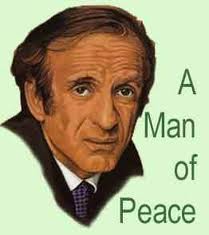 Mark Turkov, the publisher of Un di Velt Hot Gesvign (And The World Remained Silent), died in 1983, the same year Wiesel’s supporters began their campaign to get him a Nobel Prize. It is a fact that Wiesel never spoke about the Yiddish book that was the precursor to Night until after Mark Turkov’s death. As I wrote in “The Shadowy Origins of Night, Part III,” this was the time Wiesel first began to speak of being the author of the Yiddish book, which he obliquely referred to in his Nobel Prize acceptance speech in 1986, when he said “the world did know and remained silent.”
Mark Turkov, the publisher of Un di Velt Hot Gesvign (And The World Remained Silent), died in 1983, the same year Wiesel’s supporters began their campaign to get him a Nobel Prize. It is a fact that Wiesel never spoke about the Yiddish book that was the precursor to Night until after Mark Turkov’s death. As I wrote in “The Shadowy Origins of Night, Part III,” this was the time Wiesel first began to speak of being the author of the Yiddish book, which he obliquely referred to in his Nobel Prize acceptance speech in 1986, when he said “the world did know and remained silent.”
Another reason for bringing the previously ignored Yiddish book into the light is that Buchenwald survivor Myklos Grüner began, in 1987, to claim that a different Eliezer Wiesel was the author of Un di Velt Hot Gesvign, thus making it necessary for the first time for Elie to explain just how it got written — by him. That he botched the explanation so badly in his memoir is no surprise to those who have studied the man. From the article mentioned above:
Grüner writes in his book Stolen Identity (p 50), “My work of research to find Lazar Wiesel born on the 4th of September 1913 started first in 1987, to establish contact with the Archives of Buchenwald.” He was also writing to politicians and newspapers in Sweden. This could not have failed to attract the notice of Elie Wiesel and his well-developed public relations network. Grüner tracked down Un di Velt Hot Gesvign as the original book from which Night was taken, and believed it was written by his friend Lazar Wiesel and stolen somehow by Elie. (p 43)
This could account for why Elie Wiesel suddenly began to speak and write about ‘his’ Yiddish book, published in Buenos Aires, Argentina in 1956. He deals with it in his memoir All Rivers, published in 1995, after Turkov and everyone else associated with it are dead. No witnesses.
Is it too far-fetched to believe that Turkov agreed to remain silent about the real author of Un di Velt Hot Gesvign, either by being bought off, threatened, or even voluntarily? And once Turkov was safely dead, Wiesel and his supporters could breathe more easily about claiming his authorship of the book.
It is a strange fact that the title Un di Velt Hot Gesvign (or, in English, And the World Remained Silent) does not appear on the long list of “books by Elie Wiesel” at the beginning of his memoir All Rivers, nor in the original or in the new 2006 translation of Night. It also does not appear in the complete list of his books at The Elie Wiesel Foundation for Humanity. It is, however, at the beginning of the list of his books on Wikipedia. Clearly, there is uncertainty about this book, perhaps a desire by publishers not to put down in writing something that could bring them a lawsuit … or perhaps a wish by Wiesel not to stimulate questions about that book for which he has no answers.
Conclusions
1. The characters in Night are only loosely based on Elie Wiesel and his family. Therefore it can’t be called an autobiography.
2. Elie Wiesel is the author of Night, written in French with the assistance of his editor and probably Francois Mauriac, but he is probably not the author of Un di Velt Hot Gesvign.
3. Elie Wiesel made arrangement while in Brazil/Argentina for Mark Turkov to mail him the book by Eliezer Wiesel as soon as there was a hard copy, or his relatives mailed it to him. (Elie received a copy in Dec. 1955, according to himself, but the book was not available to the public until 1956.)
4. In the winter and spring of 1956, in the United States, Elie adapted the book to a shorter version in French, which he mailed to Francois Mauriac in Paris.
5. The secrecy of the birth and death dates among Wiesel’s close relatives is to keep from contradicting what is written in Night, on which his fame and fortune truly rests. Without Night, Wiesel fades into just another Jewish-Zionist writer.
6. Elie Wiesel’s failure to correct and clarify details of his family history (especially birth and death dates of his parents, sisters and other close relatives), and of the writing and publication of Un di Velt and La Nuit, mirrors his refusal to show the number A-7713 that he says is tattooed on his left arm.
7. The essential purpose for securing a Nobel Prize for Wiesel, in literature or peace, was to solidify his reputation in light of the fragility of Night as the basis of that reputation. Nobel prize recipients are a protected species by the entire “global elite,” not just the Jews. Having himself falsely identified in the Buchenwald Liberation photo served the same purpose.
My challenge: I welcome any native Polish Yiddish speaker/reader who is also fluent in English to prove me wrong about what I have written above by providing an honest, accurate translation of Un di Velt Hot Gesvign into English so it can be compared with Night. Why hasn’t this already been done? It’s natural to be suspicious of what is kept hidden. Let’s put everything on the table so that the questions I have raised can be cleared up.
Endnotes:
1. Elie Wiesel, Memoirs: All Rivers Run to the Sea, Alfred A. Knopf, New York, 1995. 418 pp.
2. Elie Wiesel, Night, Hill and Wang, New York, 1960. 116 pp. (Original edition)
3. “One day my father saw a beautiful young girl in a carriage and was so struck by her that he ran after her, calling out, ‘Who are you?’ Of course, she did not deign to reply, but that evening the driver gave him the answer. The girl was the younger daughter of Reb Dodye Feig, of the village of Bichkev. The following year they were married, and they had four children, three girls and a boy.” (All Rivers, p 15)
4. “In Buenos Aires my cousins Voicsi and her husband Moishe-Hersh Genuth came to meet us. I gave them some articles for Yedioth Ahronoth, unaware they would be reprinted or quoted in the American Jewish press.” (All Rivers, p 241)
20 Comments
Category Featured | Tags: Tags: Elie Wiesel, Grandmother Nisel Wiesel, Hilda Wiesel, Holocaust fraud, Mendel Wiesel, Night, Shlomo Wiesel, Tzipora Wiesel, Un di Velt Hot Gesvign,
Social Networks: Facebook, Twitter, Google Bookmarks, del.icio.us, StumbleUpon, Digg, Reddit, Posterous.
Sunday, October 16th, 2011
By Carolyn Yeager

Elie Wiesel’s father Shlomo in 1942, according to Hilda Wiesel.
Is he 39 or 48 years old?
A report in the Yad Vashem Shoah Victims database by Yaakov Fishkovitz contradicts Elie Wiesel’s story about his father’s death.
Yaakov (Jacob) Fishkowitz filled out a death form in 1957 for his cousin Shlomo Wiesel, shortly after Yad Vashem first began its “Central Database of Shoah Victims Names.”1 He also filled out a form for Shlomo’s mother Nisel Basch Wiesel, his aunt. The cousins shared a maternal grandfather, Moshe Basch.
Yaakov was the son of Mentza Basch, daughter of Moshe, and Fishel Fishkovitz. Yaakov recorded Shlomo’s date of birth as 1903, which is much later than has been assumed, making Elie Wiesel’s father only 40 years old when he died! However, since Wiesel himself was 14 or 15 years old in 1943 this makes a lot more sense for an Orthodox Hasidic father-son. I will examine this further on in this article.
As seen in the two Yad Vashem Shoah Victim reports below—one by Fishkovitz and the other by Elie Wiesel—Yaakov spells the last name as both Wiesel (German) and Vizel (Roumanian). The German ‘W’ is pronounced as the English ‘V;’ similarly with s and z. He also gives both the formal name Salomon and its casual form Shlomo. Elie, on the other hand, spells his father’s name as Vizel and his own name as Eli Vizel, dropping the ‘e’ in his first name that he adopted for his post-war identity.
Shlomo’s children have never or seldom used the formal ‘Salomon’ for their father, but they do agree that Eleizer (or Leizer) and Nisel were his parents and that he was born in Sighet; that he was married and operated a store. Yaakov uses the word “merchant” while Elie uses “shop owner.” Elie adds his mother’s name, Sara Feig, but leaves his father’s date of birth blank, while also giving an incorrect date for his death according to his own book, Night.
The details from the forms (the form itself is shown in upper left corner), are translated into English from the Yiddish that was used by Elie and partially by Yaakov to fill out the forms. However, the dates can be read. The first one is by cousin Fishkovitz in 1957; the second one by son Elie in 2004, almost 50 years later.
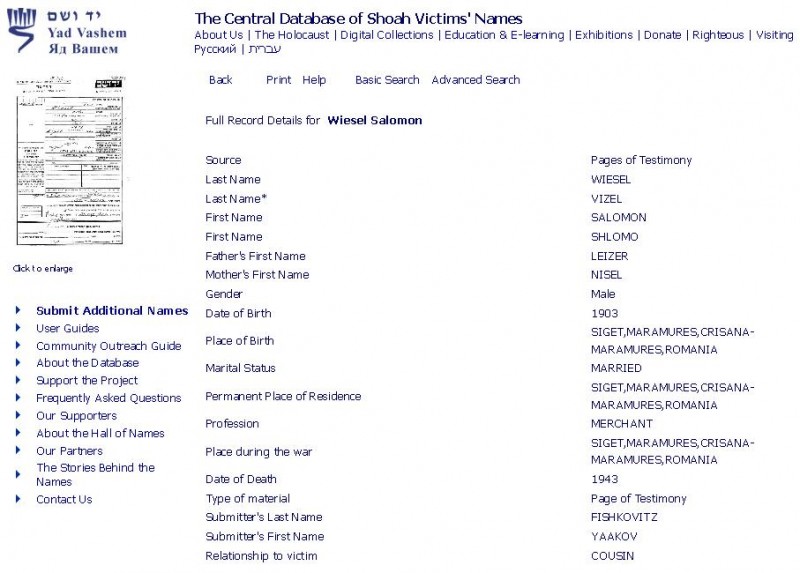
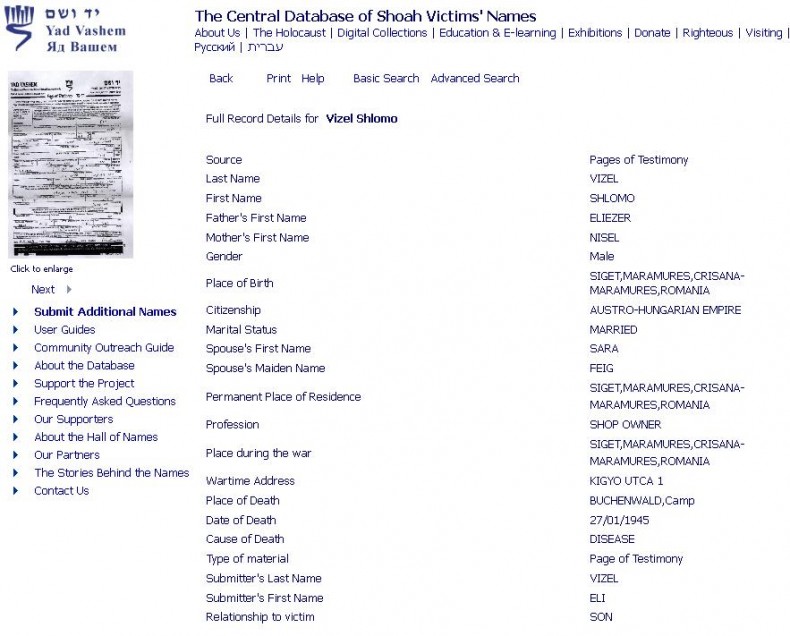
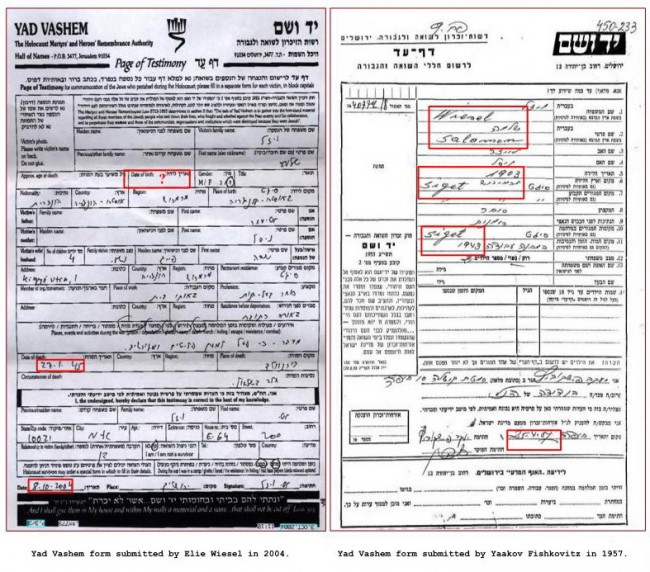
(Click on forms to see a larger, full image.) Notice that each submitter fills in what he knows or believes to be important. Yaakov knew the year of his cousin’s birth; it may have been close to his own. Elie did not know, or doesn’t want us to know. He has never written it or given that information to an interviewer. This is important, but even more important is that Yaakov says Shlomo died in 1943 in Sighet*, the year before the deportation of the Jews of Sighet! This changes the entire narrative. [*Correction was made in a later article: it actually says Shlomo lived in Sighet during the war; he died in a labor camp in 1943.]
What evidence do we have for Shlomo’s age?
In Elie Wiesel’s Night (“a true story, every word is true”) Eliezer’s father answers “fifty” when asked his age by a friendly Jew when they first arrive at Auschwitz in May 1944. Eliezer answers that he is fifteen years old. The Jew tells them to lower and raise their ages respectively, which they do. (Even so, they’re put in a line that takes them right up to the edge of a pit of fire before they are turned away.) Because of this, Shlomo Wiesel has generally been assumed to have been born in 1894, although that has never been verified. For example, Wikipedia does not give a date.
In Hilda Wiesel’s Shoah Foundation testimony, she shows the photo of her father that is at the top of this article, and says it was taken in 1942. Does he look like he is 39 in this photo (born in 1903) or does he look to be 48 (because he was 50 in 1944)? It’s impossible to tell for sure, but he looks like a youngish man to me.
As we know, there are no records at Auschwitz-Birkenau or Buchenwald for a Shlomo Wiesel that fits his profile. Nor are there any for Elie Wiesel and his profile. The records that are used by the “Wiesel-in-Buchenwald” supporters are those for Abraham Viezel (also spelled Vizel or Wiesel), born Oct. 10, 1900 in Sighet, who died at Buchenwald on Feb 2, 1945. He died in Block 57; the death report was made out on Feb. 3, the following day. Yet Elie Wiesel claims in Night and elsewhere his father died on Jan. 28 and was carted off to the cremation ovens immediately, fully 5 days before Abraham’s death took place.
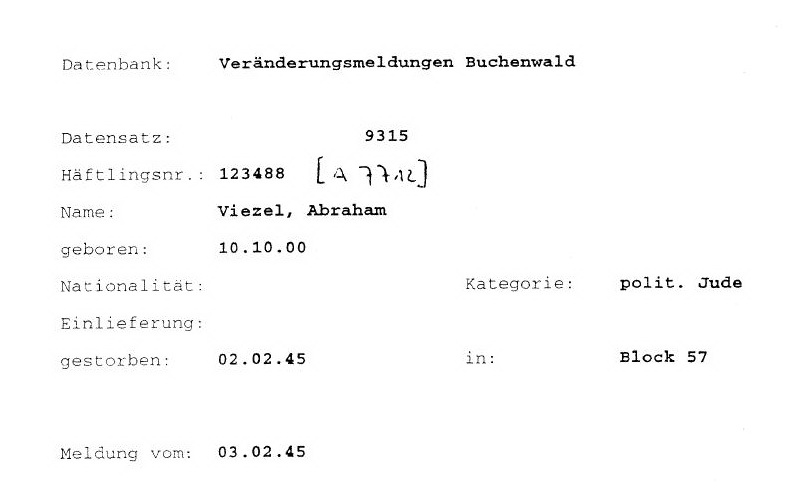
Death record for Abraham Viesel at Buchenwald, brother of Lazar Wiesel whose Auschwitz # was A7713
This Abraham Viesel is the same Abram Wiesel who was the older brother of Lazar Wiesel, according to Myklos Gruener, who says the two brothers had become his comrades at Auschwitz-Birkenau after the death of his father. (Auschwitz records exist for Myklos, his father and two brothers, as well as for Lazar and Abram Wiesel, including each of their numbers.) Abram’s Auschwitz tattoo number A7712 is written by hand on this death record, as well as his Buchenwald number, 123488.
If Shlomo died in 1943, this would explain why there is no death record for him at Buchenwald. Are there any other convincing reasons to go along with the 1943 date? Yes. In Night and in All Rivers Run to the Sea, we’re told of Shlomo’s resistance work helping Jews with legal problems and those who needed to flee from one place to another. He had been jailed for it, something mentioned by both Elie and Hilda. Elie characterized his father’s tireless efforts as “out of a loving, helpful heart.” But was his father, and his family, more radical than we’ve been led to believe? Was Shlomo’s life a dangerous one? Were there disputes about money—money collected to buy weapons, or for passage to safe places? Or perhaps there was anger within the Jewish community over who was being helped and who wasn’t?
In All Rivers, on page 4, Wiesel writes that as a child and adolescent he “saw his father rarely […] The Sabbath was the only day I spent with him.” “Often preoccupied,” his father spent the week in his little grocery store and at the “community offices where he worked to assist prisoners and refugees threatened with expulsion.” Expulsion from where? By whom? What were the community offices? Wiesel names Sighet as a “sanctuary for Jews fleeing …since 1640.”
What knowledge can we piece together about Shlomo?
Shlomo was a preoccupied man. He ran a store. He took in deliveries. He may have been involved in smuggling – guns, people, documents. Smuggling was a way of life among the Zionists. Jews began going to Palestine long before Elie Wiesel was born. There were different factions of Jews—the Haganah was formed in 1920 to guard Jewish settlers in Palestine. In 1931 the Irgun splintered off and there was sometimes bitter enmity between the two organizations all the way up to 1948. The Irgun policy was that every Jew had a right to enter Palestine and it became the major smuggling arm for the Zionists. The Irgun worked in Poland, for example, in the 30’s to bring Jews into Palestine with the cooperation of secret agencies of the Polish government. (See “The Role of the Irgun in Central and Eastern Europe” at http://www.eliewieseltattoo.com/elie-wiesel-and-the-mossad-part-ii)
It is fully possible that as things heated up in 1943, Shlomo got caught in some crossfire — perhaps was killed by the Hungarian police. If this were the case, Elie, as only son, may have been sent to France for safety before the deportations of Spring 1944. Further, if this were the case (a story as good as any other), Elie was an Irgun-supporting Zionist from an early age, which fits everything we know about him.
On page 8 of Night, Wiesel wrote:
In those days [Spring 1944] it was still possible to buy emigration certificates to Palestine. I had asked my father to sell everything, to liquidate everthing, and to leave. ‘I am too old, my son,’ he answered. ‘Too old to start a new life. Too old to start from scratch in some distant land …’
If he were only 40, that is not credible. Even at 50 he was not too old, unless he really didn’t believe the worst would happen and that things would right themselves. His children were certainly not too old and he would have them to look after him in his old age. Something doesn’t add up here. This “good man” doesn’t protect his family because he feels too tired at age 40-50 to go somewhere new? He allows them all to be taken prisoner because he can’t see what’s coming, even though he’s spent his adult life helping Jewish prisoners and refugees? Wiesel often fails to give convincing explanations for why events happen as they do in his writings. I have noticed it again and again, and commented on it. It seems to me to be a combination of laziness and lack of true inventiveness. He has admitted that he was rather spoiled and lazy in his childhood and youth; one doesn’t see any evidence of change.
The age of the typical Hasidic bride and groom
Back to the question of the appropriateness of Sholmo Wiesel being age 40 in 1943-44. The Hasidic sect sees the ideal age of marriage for a male as 18-21. They encourage the bride and groom to be close in age. Taken from the New York Times article on an important Hasidic wedding:
What they saw was a marital merger of two leading international Hasidic dynasties, the Bobovers of the Borough Park neighborhood in Brooklyn and the Satmars of Williamsburg. The 19-year-old groom is a grandson of the Bobover Grand Rabbi, Shlomo Halberstam. The 18-year-old bride is a granddaughter of the Satmar Grand Rabbi, Moses Teitelbaum. The two grand rabbis are the descendants of the first Hasidic leaders in Europe. They are also first cousins and close friends.2
Another Hasidic wedding is announced, this one in Israel.
Even longtime Hassidim are raising their eyebrows: A 16-year-old young man is engaged to his 15-year-old second cousin, both great grandchildren from “Hassidei Vizhnitz.” Thousands of members of the Vizhnitz Hassidic sect, one of the largest and wealthiest in the world, are expected to attend the festive wedding ceremony, which will take place in approximately another year.3
If Shlomo were born in 1903, as Yaakov Fishkowitz has it, he would have been 25 years old in September 1928 when his third child and first son Eliezer was born. His first child Hilda was born in August 1922, when he would have been 19 years old. Perfect for a Hasidic man!
On the other hand, if he were born in 1894, he was already 34 when Elie was born, and 28 when he had his first child. That is too old and is not in the tradition of his community! That may be why Wiesel avoids mentioning his father’s date of birth; it does not fit the story of Night, which he adopted as his own. Here’s a thought: Is there an Hasidic law or tradition that forbids lying about one’s parents and other ancestors? Probably, which can be the reason he says so little about his father, mother and grandparents as far as checkable data goes.
Is it not strange for the ‘High Priest of Memory’ to be so negligent in recording the history of his family? He only filled out the Yad Vashem form (with a camera aimed at him) at the behest of that institution, as an encouragement to others to do the same. That was admitted in the TV publicity given it. Plus it is the only Shoah victim form he filled out. His mother and sister are not in the Yad Vashem Shoah Victim database! He says it’s because he’s written about them in books, so the bare facts on a form are not necessary. But in his books, he doesn’t give dates or checkable details. Why has no family member recognized the death at Auschwitz of Sara Feig Wiesel and her daughter Tzipora by filling out a form?
Is Elie Wiesel’s story about his family and their fate entirely or just partially false?
We know Wiesel’s story about his family and youth to be full of falsehoods. His book Night has been lampooned as much as it has been praised because of the contradictions and inappropriate descriptions of people and events it contains. He has long been described as a fabricator, an exaggerator, a false witness. However, here at Elie Wiesel Cons the World our mission is to expose every lie, not just the most obvious of them. So we dig deeper.
Elie Wiesel has every reason to want his father with him at Buchenwald since the story in Night, which started out as fiction, is about a son and his father. The story also says his mother and younger sister perished on their first night in Birkenau. But if Shlomo died in 1943 and never went to Auschwitz, did any of his immediate family go? Remember, there are no records for any of them there.
Could Elie Wiesel have known in 1955 how huge the Holocaust Industry would become? No, no one did. Would Elie Wiesel in 1958 have anticipated the intense scrutiny of this book Night, or his own star status in which he himself would come under intense scrutiny? No, again. Elie Wiesel didn’t prepare for the kind of future he turned out to have, so he’s been “playing it by ear” ever since—and using his untouchable Jewish holocaust survivor status with which to protect himself. His sisters and other family members and friends were silenced to keep the ‘wrong’ information from slipping out. Journalists were obviously ordered to stay away from them!
But, perhaps unbeknownst to their inner circle, there lay two victim reports with vital information relating to Elie Wiesel in the Yad Vashem databank filled out in 1957 by Yaakov Fishkovitz, one of which is displayed in this article. The other is for his aunt—Shlomo’s mother—Nisel Basch Wiesel, stating she was born in 1881 and died in 1944 at Auschwitz (in her 63rd year). Another form for Nisel was filled out in 1999 by her grandson, Eliezer Shlomovitz, living in Los Angeles CA. He gives her date of birth as 1880 with a question mark. I will write about Nisel Wiesel in a separate article, but for now I want to establish that if Nisel were born in 1880-81 she would have been only 13 years old when she gave birth to her son Shlomo, if he were born in 1894. Since Shlomo was not her first child, but perhaps even her fifth or sixth (undetermined as of now), this is clearly impossible. If Shlomo were born in 1903, it is doable.
Thus, we have every reason to doubt everything about Elie Wiesel’s story of his family history and their concentration camp credentials. I will continue with this fascinating and very important examination of the Wiesel extended family in an upcoming article. Stay tuned.
Endnotes:
1. Yad Vashem was established in 1953 as the official “remembrance authority” (for the Jewish Shoah) by the Knesset, Israel’s parliament. At that time, Jews were told that all Jews who died at the hands of the Nazis or their accomplices during the years of Nazi power, i.e. 1933-1945 could be considered Shoah victims. This includes Jewish soldiers serving in the Soviet and Polish armies, who were taken prisoner and died in Nazi POW camps. Jews who survived until the liberation but died within six months of liberation are also considered Shoah victims.
Another category is ‘Shoah survivor’ All those living in Nazi-occupied territories from 1933 onward could be considered victims of the Nazis, including French, Bulgarian and Romanian Jews, and even those who went deep into the Soviet Union. Also included are “Jews who forcefully left (?) Germany in the 1930s.” Even those who went to Israel, obviously No other group has so generously allocated ‘victim-opportunities’ to its people. This is called Chutzpah in Yiddish. (Information taken from http://www.yadvashem.org/wps/portal/!ut/p/_s.7_0_A/7_0_S5?New_WCM_Context=http://namescm.yadvashem.org/wps/wcm/connect/Yad+Vashem/Hall+Of+Names/Left+Links/en/3HON_FAQs)
2. http://www.nytimes.com/1998/09/04/nyregion/a-royal-wedding-a-family-affair-two-hasidic-dynasties-unite-in-brooklyn-gala.html?pagewanted=all&src=pm Further of interest: The Satmars originated in Hungary and the Bobovers came from Poland. […] Because Hasidic families often have 10 or more children, the two groups now have tens of thousands of followers in Brooklyn and more around the world.
3. http://www.israelnationalnews.com/News/News.aspx/133130 “We have a tradition of marrying at a young age, but we usually mean 19-22, although there have been occasions of marriages before the age of 18,” one Vizhnitz member told the Hebrew-language daily Yisrael HaYom. “However, marrying at the age of 15 is definitely exceptional.”
Please read this article next: New Information – Shlomo Wiesel dies in labor camp in 1943?
14 Comments
Category Featured | Tags: Tags: Abraham Viesel, Buchenwald, Elie Wiesel, Hasidic marriage, Hilda Wiesel, Night, Shlomo Wiesel, Yaakov Fishkovitz, Yad Vashem Shoah Victims Database,
Social Networks: Facebook, Twitter, Google Bookmarks, del.icio.us, StumbleUpon, Digg, Reddit, Posterous.
Friday, September 23rd, 2011
By Carolyn Yeager
The real inmate at Buchenwald, Lazar Wiesel, 31 years old in 1944, was the son of Szalamo and Serena Feig Wiesel of Sighet.
We present the question of why the personal information on Lazar Wiesel is so close, but still far from exact, to that of Elie Wiesel. Can we believe, as Prof. Kenneth Waltzer would have it, that these were errors in taking down the information on Elie, and Lazar is really Elie? No, we can’t because the nature of the differences cannot be simple errors. Lazar had a brother Abram with him in the camps; the 44 year-old Abram (in 1944) cannot be turned into Elie’s father. And he certainly can’t be turned into Lazar’s father as only 13 years separated them. But it is very possible that the two families were related and that a part of Elie’s immediate family escaped the deportation altogether. Many so-called Hungarian Jews did – many more than are officially acknowledged. Keeping this in mind, I will examine the family names and see what they tell us.
Lazar Wiesel’s Buchenwald File Card (below) records Lazar’s father, Szalamo (equates to Sholomo), as being interned at Buchenwald.1 But more striking, Lazar’s mother, Serena Wiesel nee Feig, is listed on this card as being interned at KL Auschwitz. (As we know, Elie’s story is that upon arrival he saw his mother and sister moving away with the women and never saw them again. The idea they went to a gas chamber is pure speculation copied from other books.)
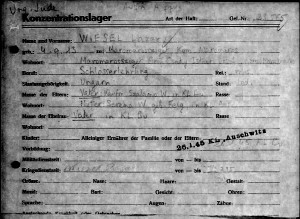
CLICK ON CARD FOR AN ENLARGED VIEW. Buchenwald Registration file card for Lazar Wiesel, birth date Sept, 4, 1913, arriving on Jan. 26, 1945 from KL Auschwitz.
Elie Wiesel’s parents are known to be Shlomo and Sara (or Sura) Wiesel, nee Feig.
In Jewish Orthodoxy (the Wiesel’s were members of the Hasidim sect) and in Eastern Europe generally, certain family names were repeatedly used—recycled if you will. This is certainly the case in the Wiesel family with the names Eliezer, Elisha, Shlomo and Sara, and probably some others we don’t know about.
It’s no surprise that we find the name of the founder of Hasidic Judaism to be Rabbi Yisroel ben Eliezer, and that he was born to Eliezer and Sara in Okopy, a small village that over the centuries has been part of Poland, Russia, and now Ukraine.
Wiesel was named after his grandfather Eliezer. His other grandfather on the maternal side is Dovid Feig.
Looking for genealogical information on Elie Wiesel is a disappointing affair—so little can be found. For such a famous person, a Nobel Peace Prize Laureate, to have his family history wiped away, hidden or not known is strange indeed. How to explain it when Hasidic family ancestry is traditionally honored and held in high esteem. It must be purposely hidden. The Jews talk about Adolf Hitler hiding his ancestry. Not at all. Hitler’s complete and accurate genealogy is available on the Internet, but Wiesel’s is not. How do we figure that?
The #1 site on Google Search for Wiesel’s genealogy is Geni which has only very limited information. There is nothing additional to be found on Wikipedia. I have filled in the gaps with two pages of testimony from Yad Vashem’s online database—one for his father that Wiesel filled out himself, and one for his father’s mother, Nisel, that was filled out by her grandson Eliezer Shlomovitz, who lives in Los Angeles, CA. This is all I could uncover and I do not guarantee the correctness of any of it.
Father: Shlomo Elisha Wiesel
- Parents: Eliezer Vizel and Nisel Vizel nee Bash. This grandfather Eliezer died serving on the side of the Austro-Hungarian Empire in WWI.
- Nisel was born in Chust (or Hust, not far from Sighet), later Ruthenian-Czechoslovakia , in 1880 to Moshe and Yehudit Bash, according to a Yad Vashem death report (mentioned above).
- Shlomo is said by several sources to have been born in 1894, but I think this is deduced from the book “Night” where he is said to have been age 50 in 1944. If this were correct, it would make Shlomo’s mother’s age 14 when he was born — highly unlikely. Elie Wiesel never gives his father’s or mother’s birth dates though it’s not like he doesn’t know.
- Wiesel writes in his memoir All Rivers Run to the Sea that he met his father’s brother Samuel in New York, but he has never written about his cousin Eliezer Shlomovitz in Los Angeles.
Mother: Sara Feig Wiesel
- Parents: Dodye (Dovid) Feig; no mother given
- Wiesel highly praises this grandfather in All Rivers and writes, “… in 1944 my parents invited him and his wife to live with us.” His wife, not ‘my grandmother.’ That is the only mention of ‘her.’ Seems clear she was not Elie’s grandmother, but a new wife. In any case, grandfather Feig declined and went to stay with his sons.
- Elie writes in All Rivers: “I had four uncles on my mother’s side: Chaim-Mordechai, Ezra, Israel and Moshe-Itzik
- He met an ‘Uncle’ Morris in New York.
From the little we have available, we can see certain names repeating. Elie Wiesel gave his son his father’s name, Shlomo Elisha. He himself was named after his paternal grandfather Eliezer. A cousin, another grandson of his paternal grandmother, is also named Eliezer. This cousin’s last name is Shlomovitz. From this we can begin to ascertain that Eliezer, Shlomo, Elisha and Sara are “family names” within the extended Wiesel family, along with being Hasidic names.
Two marriages between the Wiesel’s and the Feig’s
Looking back at the Lazar (from Eliezer) Wiesel who was at Buchenwald, we see another marriage between the Wiesel’s and the Feig’s. We see the same names: father is Szalamo (Shlomo); mother is Serena Feig. Lazar is 15 years older than Elie and his brother Abram is 28 years older, and they are from the same city, Sighet. It seems pretty clear to me that these are two branches of the family tree.
Matchmaker, Matchmaker, make me a match!
 Orthodox men and women usually meet through matchmakers in a process called a shidduch. A matchmaker’s services are necessary because of the constant intermarriage going on within the closely knit Orthodox communities. A matchmaker (shadchan) knew of the relations between those in the community, or could find them out, and could therefore prevent or warn against marriages between a couple who were too genetically similar. This role is not mentioned on Wikipedia and other Jewish sites, but it’s the most important one. In Night, Wiesel wrote that in 1943 his mother “was beginning to think it was high time to find an appropriate match for Hilda” who was already 21 years of age.2
Orthodox men and women usually meet through matchmakers in a process called a shidduch. A matchmaker’s services are necessary because of the constant intermarriage going on within the closely knit Orthodox communities. A matchmaker (shadchan) knew of the relations between those in the community, or could find them out, and could therefore prevent or warn against marriages between a couple who were too genetically similar. This role is not mentioned on Wikipedia and other Jewish sites, but it’s the most important one. In Night, Wiesel wrote that in 1943 his mother “was beginning to think it was high time to find an appropriate match for Hilda” who was already 21 years of age.2
The two families, Feig and Wiesel, may have been recognized as having diverse enough genetic relationship to one another to make for viable marriages. Perhaps there was a history of successful unions between the two family lines. In any case, it can explain the similarity in personal information between the older and younger Wiesel, and also the temptation to claim the one to be the other. The family members can be trusted to remain silent about it.
This last part is speculation, but one thing we notice is that Elie Wiesel does not want us to know who or where are the members of his family, and even more, he doesn’t want any of his family members to talk to us, the general public. We are not to know anything but the simplistic legend that he and his supporters and defenders have created for our consumption.
An interesting side-note: I just discovered a book From Generation to Generation by Arthur Kurzweil, published in 2004, which features on the cover “Foreword by Elie Wiesel.” This foreword turns out to be only one page long, much shorter than the Acknowledgements even, and consists of a few vague words about the mystical aspect of names. What is interesting is that the book is 400 pages of “how to research your Jewish genealogy.” If Wiesel has researched his own, he certainly is not publishing it. Wiesel gives himself the prerogative of remaining a very private man, while working hard to become a highly public name. Jewish chutzpah at work.~
Endnotes:
1. Myklos Gruener never mentioned a father for Lazar and Abram, only his own father.
2. Elie Wiesel, Night, Hill and Wang, 2006 (original copyright 1958), p. 8
1 Comment
Category Featured | Tags: Tags: Abram Wiesel, Buchenwald, Elie Wiesel, Lazar Wiesel, matchmakers, Sara and Serena Wiesel nee Feig, Shlomo Wiesel,
Social Networks: Facebook, Twitter, Google Bookmarks, del.icio.us, StumbleUpon, Digg, Reddit, Posterous.


![Elie Wiesel's left arm in bright sunlight in a still from his own video "Elie Wiesel Goes Home" - no retouching. [courtesy Eric Hunt]](https://www.eliewieseltattoo.com/wp-content/uploads/2012/01/EW_arm-no-tattoo1-e1450887466391.jpg)




























